Bicycle Model for Public Health intervention Assignment
VerifiedAdded on 2021/06/14
|29
|5295
|215
AI Summary
Contribute Materials
Your contribution can guide someone’s learning journey. Share your
documents today.
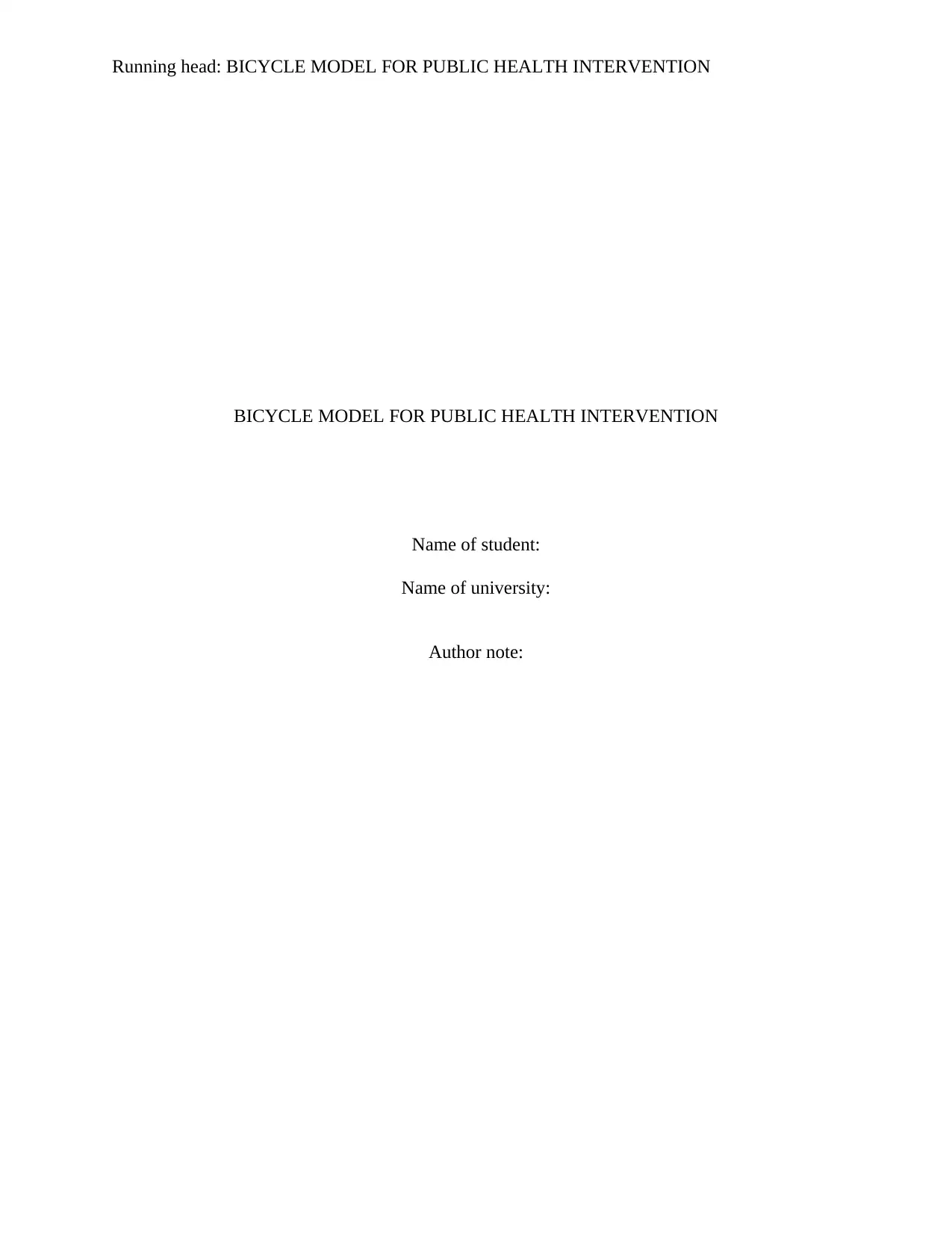
Running head: BICYCLE MODEL FOR PUBLIC HEALTH INTERVENTION
BICYCLE MODEL FOR PUBLIC HEALTH INTERVENTION
Name of student:
Name of university:
Author note:
BICYCLE MODEL FOR PUBLIC HEALTH INTERVENTION
Name of student:
Name of university:
Author note:
Secure Best Marks with AI Grader
Need help grading? Try our AI Grader for instant feedback on your assignments.
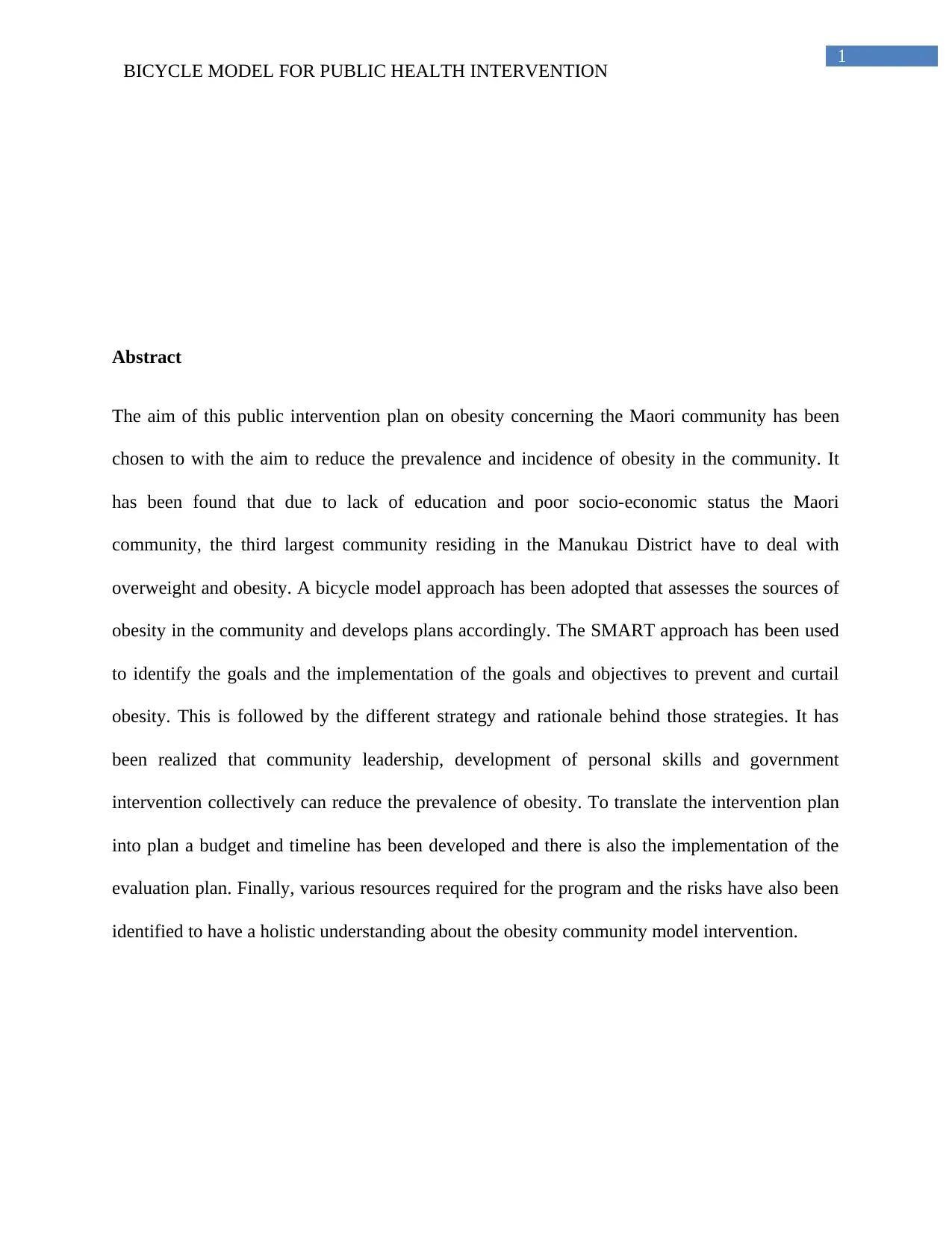
1
BICYCLE MODEL FOR PUBLIC HEALTH INTERVENTION
Abstract
The aim of this public intervention plan on obesity concerning the Maori community has been
chosen to with the aim to reduce the prevalence and incidence of obesity in the community. It
has been found that due to lack of education and poor socio-economic status the Maori
community, the third largest community residing in the Manukau District have to deal with
overweight and obesity. A bicycle model approach has been adopted that assesses the sources of
obesity in the community and develops plans accordingly. The SMART approach has been used
to identify the goals and the implementation of the goals and objectives to prevent and curtail
obesity. This is followed by the different strategy and rationale behind those strategies. It has
been realized that community leadership, development of personal skills and government
intervention collectively can reduce the prevalence of obesity. To translate the intervention plan
into plan a budget and timeline has been developed and there is also the implementation of the
evaluation plan. Finally, various resources required for the program and the risks have also been
identified to have a holistic understanding about the obesity community model intervention.
BICYCLE MODEL FOR PUBLIC HEALTH INTERVENTION
Abstract
The aim of this public intervention plan on obesity concerning the Maori community has been
chosen to with the aim to reduce the prevalence and incidence of obesity in the community. It
has been found that due to lack of education and poor socio-economic status the Maori
community, the third largest community residing in the Manukau District have to deal with
overweight and obesity. A bicycle model approach has been adopted that assesses the sources of
obesity in the community and develops plans accordingly. The SMART approach has been used
to identify the goals and the implementation of the goals and objectives to prevent and curtail
obesity. This is followed by the different strategy and rationale behind those strategies. It has
been realized that community leadership, development of personal skills and government
intervention collectively can reduce the prevalence of obesity. To translate the intervention plan
into plan a budget and timeline has been developed and there is also the implementation of the
evaluation plan. Finally, various resources required for the program and the risks have also been
identified to have a holistic understanding about the obesity community model intervention.
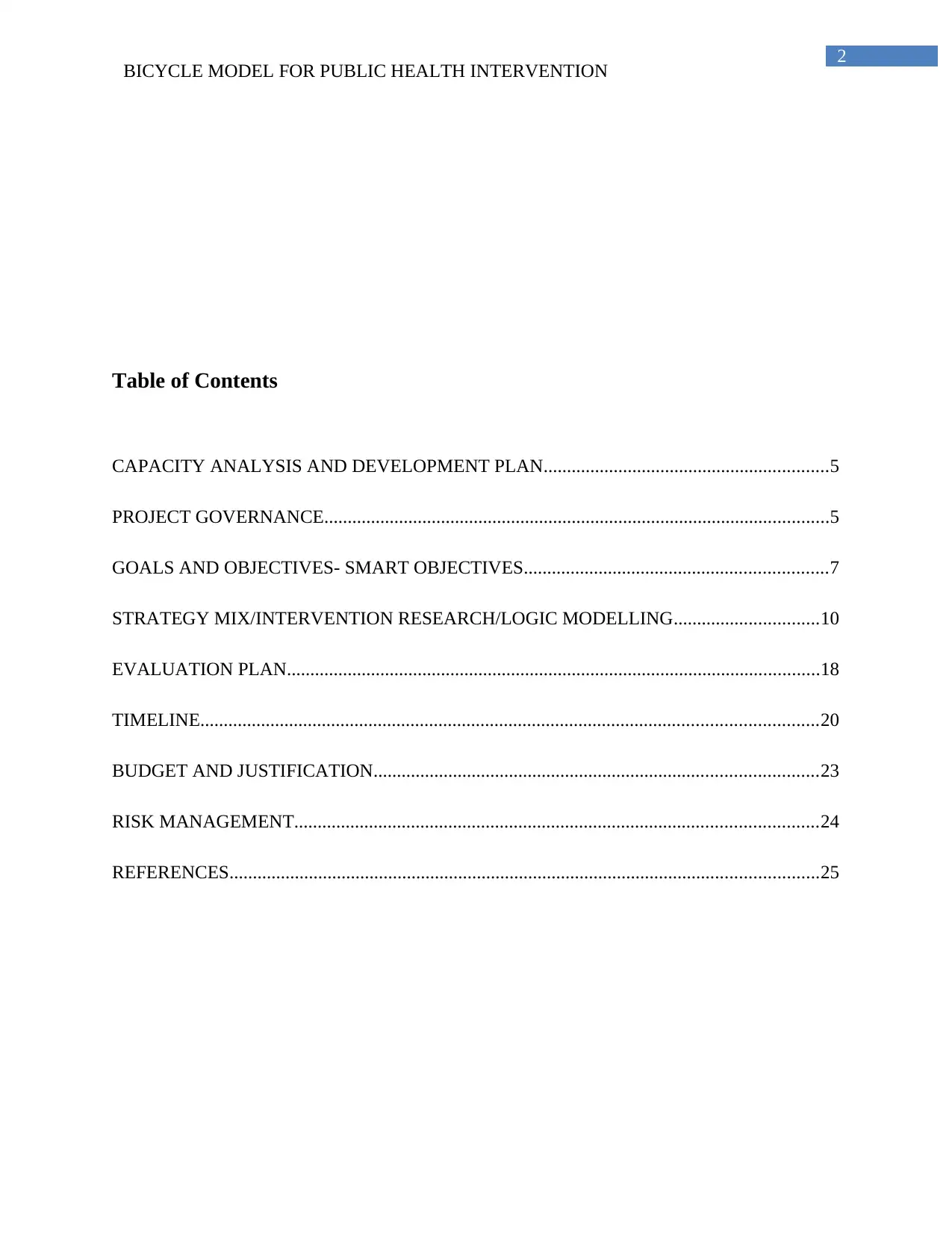
2
BICYCLE MODEL FOR PUBLIC HEALTH INTERVENTION
Table of Contents
CAPACITY ANALYSIS AND DEVELOPMENT PLAN.............................................................5
PROJECT GOVERNANCE............................................................................................................5
GOALS AND OBJECTIVES- SMART OBJECTIVES.................................................................7
STRATEGY MIX/INTERVENTION RESEARCH/LOGIC MODELLING...............................10
EVALUATION PLAN..................................................................................................................18
TIMELINE....................................................................................................................................20
BUDGET AND JUSTIFICATION...............................................................................................23
RISK MANAGEMENT................................................................................................................24
REFERENCES..............................................................................................................................25
BICYCLE MODEL FOR PUBLIC HEALTH INTERVENTION
Table of Contents
CAPACITY ANALYSIS AND DEVELOPMENT PLAN.............................................................5
PROJECT GOVERNANCE............................................................................................................5
GOALS AND OBJECTIVES- SMART OBJECTIVES.................................................................7
STRATEGY MIX/INTERVENTION RESEARCH/LOGIC MODELLING...............................10
EVALUATION PLAN..................................................................................................................18
TIMELINE....................................................................................................................................20
BUDGET AND JUSTIFICATION...............................................................................................23
RISK MANAGEMENT................................................................................................................24
REFERENCES..............................................................................................................................25
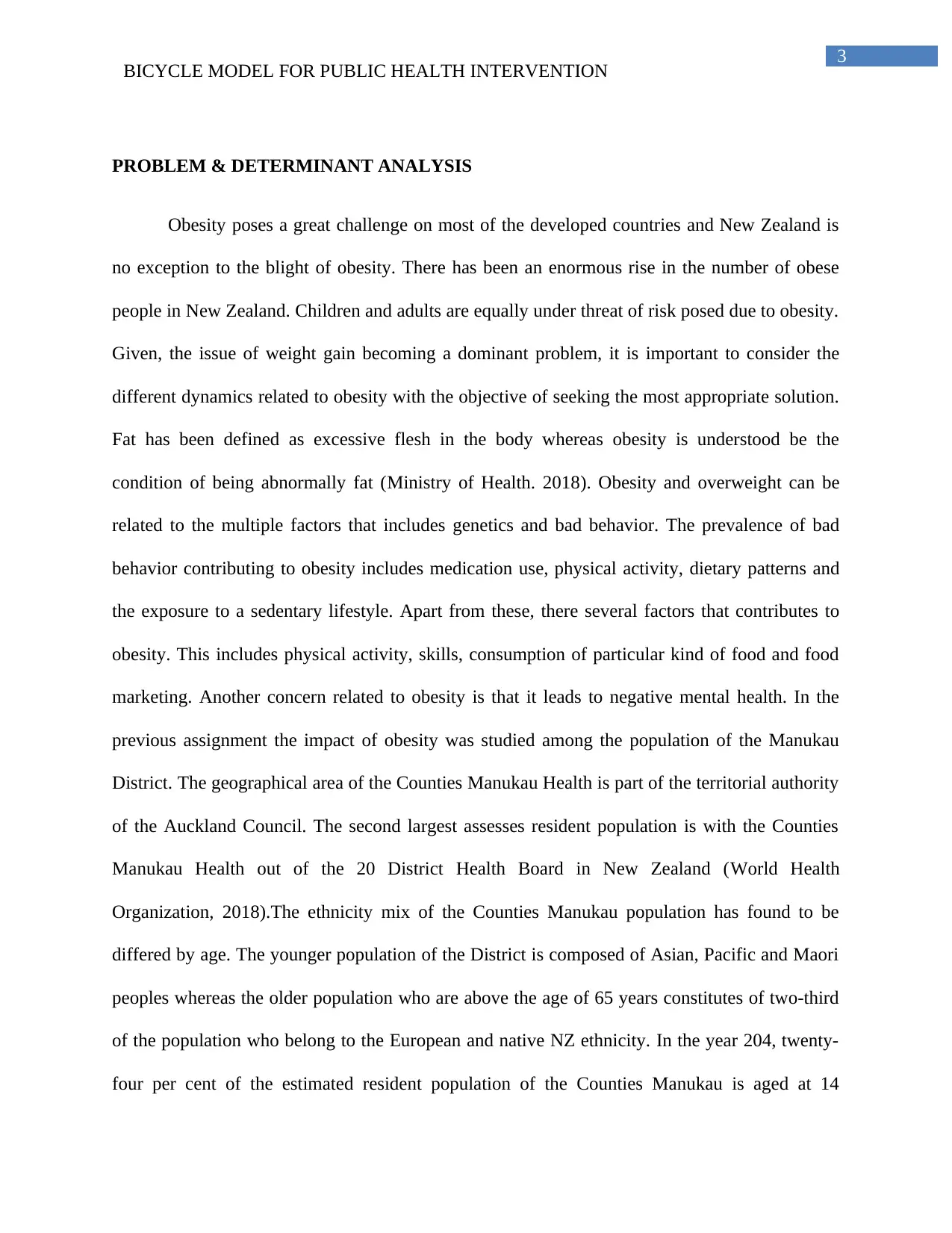
3
BICYCLE MODEL FOR PUBLIC HEALTH INTERVENTION
PROBLEM & DETERMINANT ANALYSIS
Obesity poses a great challenge on most of the developed countries and New Zealand is
no exception to the blight of obesity. There has been an enormous rise in the number of obese
people in New Zealand. Children and adults are equally under threat of risk posed due to obesity.
Given, the issue of weight gain becoming a dominant problem, it is important to consider the
different dynamics related to obesity with the objective of seeking the most appropriate solution.
Fat has been defined as excessive flesh in the body whereas obesity is understood be the
condition of being abnormally fat (Ministry of Health. 2018). Obesity and overweight can be
related to the multiple factors that includes genetics and bad behavior. The prevalence of bad
behavior contributing to obesity includes medication use, physical activity, dietary patterns and
the exposure to a sedentary lifestyle. Apart from these, there several factors that contributes to
obesity. This includes physical activity, skills, consumption of particular kind of food and food
marketing. Another concern related to obesity is that it leads to negative mental health. In the
previous assignment the impact of obesity was studied among the population of the Manukau
District. The geographical area of the Counties Manukau Health is part of the territorial authority
of the Auckland Council. The second largest assesses resident population is with the Counties
Manukau Health out of the 20 District Health Board in New Zealand (World Health
Organization, 2018).The ethnicity mix of the Counties Manukau population has found to be
differed by age. The younger population of the District is composed of Asian, Pacific and Maori
peoples whereas the older population who are above the age of 65 years constitutes of two-third
of the population who belong to the European and native NZ ethnicity. In the year 204, twenty-
four per cent of the estimated resident population of the Counties Manukau is aged at 14
BICYCLE MODEL FOR PUBLIC HEALTH INTERVENTION
PROBLEM & DETERMINANT ANALYSIS
Obesity poses a great challenge on most of the developed countries and New Zealand is
no exception to the blight of obesity. There has been an enormous rise in the number of obese
people in New Zealand. Children and adults are equally under threat of risk posed due to obesity.
Given, the issue of weight gain becoming a dominant problem, it is important to consider the
different dynamics related to obesity with the objective of seeking the most appropriate solution.
Fat has been defined as excessive flesh in the body whereas obesity is understood be the
condition of being abnormally fat (Ministry of Health. 2018). Obesity and overweight can be
related to the multiple factors that includes genetics and bad behavior. The prevalence of bad
behavior contributing to obesity includes medication use, physical activity, dietary patterns and
the exposure to a sedentary lifestyle. Apart from these, there several factors that contributes to
obesity. This includes physical activity, skills, consumption of particular kind of food and food
marketing. Another concern related to obesity is that it leads to negative mental health. In the
previous assignment the impact of obesity was studied among the population of the Manukau
District. The geographical area of the Counties Manukau Health is part of the territorial authority
of the Auckland Council. The second largest assesses resident population is with the Counties
Manukau Health out of the 20 District Health Board in New Zealand (World Health
Organization, 2018).The ethnicity mix of the Counties Manukau population has found to be
differed by age. The younger population of the District is composed of Asian, Pacific and Maori
peoples whereas the older population who are above the age of 65 years constitutes of two-third
of the population who belong to the European and native NZ ethnicity. In the year 204, twenty-
four per cent of the estimated resident population of the Counties Manukau is aged at 14
Secure Best Marks with AI Grader
Need help grading? Try our AI Grader for instant feedback on your assignments.
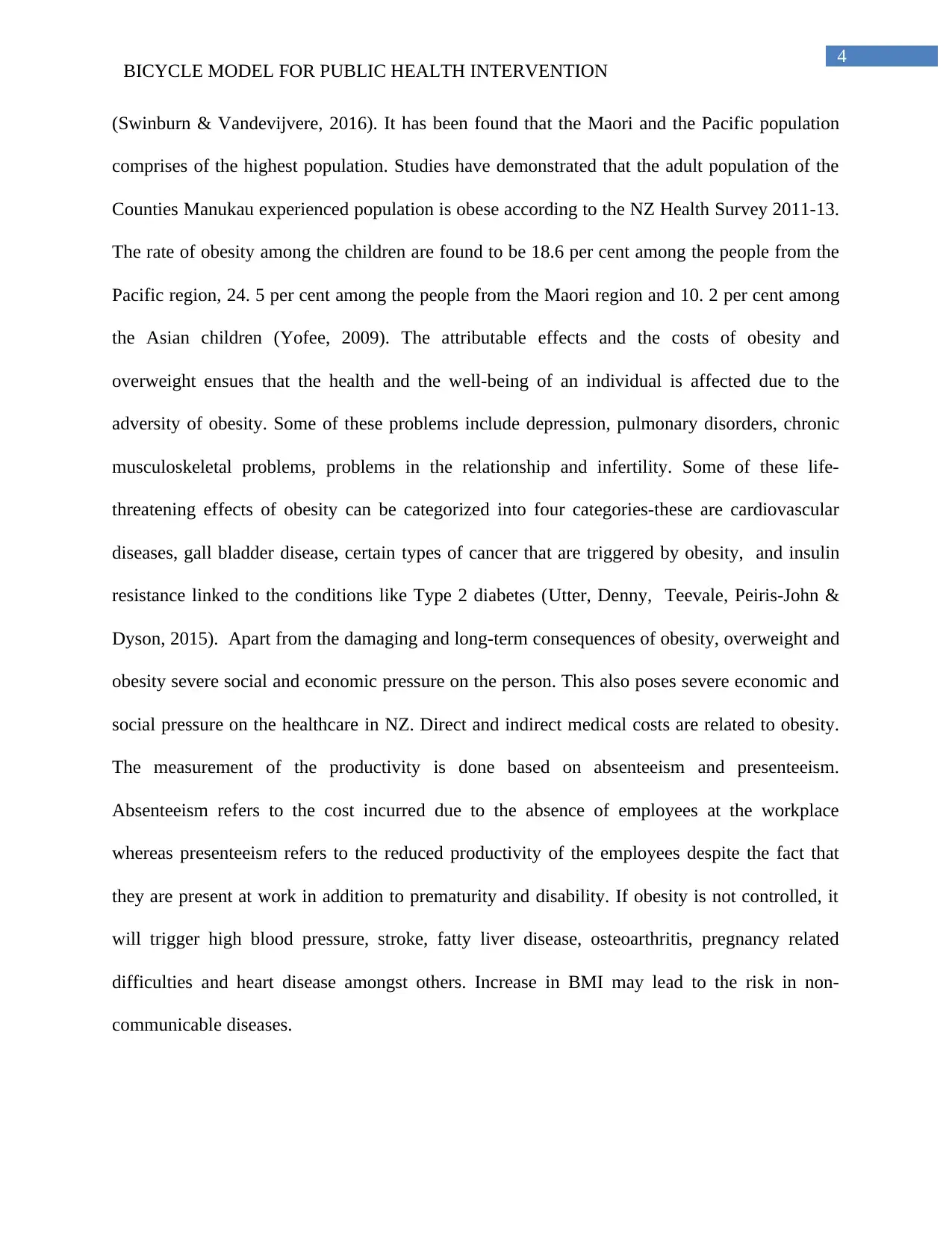
4
BICYCLE MODEL FOR PUBLIC HEALTH INTERVENTION
(Swinburn & Vandevijvere, 2016). It has been found that the Maori and the Pacific population
comprises of the highest population. Studies have demonstrated that the adult population of the
Counties Manukau experienced population is obese according to the NZ Health Survey 2011-13.
The rate of obesity among the children are found to be 18.6 per cent among the people from the
Pacific region, 24. 5 per cent among the people from the Maori region and 10. 2 per cent among
the Asian children (Yofee, 2009). The attributable effects and the costs of obesity and
overweight ensues that the health and the well-being of an individual is affected due to the
adversity of obesity. Some of these problems include depression, pulmonary disorders, chronic
musculoskeletal problems, problems in the relationship and infertility. Some of these life-
threatening effects of obesity can be categorized into four categories-these are cardiovascular
diseases, gall bladder disease, certain types of cancer that are triggered by obesity, and insulin
resistance linked to the conditions like Type 2 diabetes (Utter, Denny, Teevale, Peiris-John &
Dyson, 2015). Apart from the damaging and long-term consequences of obesity, overweight and
obesity severe social and economic pressure on the person. This also poses severe economic and
social pressure on the healthcare in NZ. Direct and indirect medical costs are related to obesity.
The measurement of the productivity is done based on absenteeism and presenteeism.
Absenteeism refers to the cost incurred due to the absence of employees at the workplace
whereas presenteeism refers to the reduced productivity of the employees despite the fact that
they are present at work in addition to prematurity and disability. If obesity is not controlled, it
will trigger high blood pressure, stroke, fatty liver disease, osteoarthritis, pregnancy related
difficulties and heart disease amongst others. Increase in BMI may lead to the risk in non-
communicable diseases.
BICYCLE MODEL FOR PUBLIC HEALTH INTERVENTION
(Swinburn & Vandevijvere, 2016). It has been found that the Maori and the Pacific population
comprises of the highest population. Studies have demonstrated that the adult population of the
Counties Manukau experienced population is obese according to the NZ Health Survey 2011-13.
The rate of obesity among the children are found to be 18.6 per cent among the people from the
Pacific region, 24. 5 per cent among the people from the Maori region and 10. 2 per cent among
the Asian children (Yofee, 2009). The attributable effects and the costs of obesity and
overweight ensues that the health and the well-being of an individual is affected due to the
adversity of obesity. Some of these problems include depression, pulmonary disorders, chronic
musculoskeletal problems, problems in the relationship and infertility. Some of these life-
threatening effects of obesity can be categorized into four categories-these are cardiovascular
diseases, gall bladder disease, certain types of cancer that are triggered by obesity, and insulin
resistance linked to the conditions like Type 2 diabetes (Utter, Denny, Teevale, Peiris-John &
Dyson, 2015). Apart from the damaging and long-term consequences of obesity, overweight and
obesity severe social and economic pressure on the person. This also poses severe economic and
social pressure on the healthcare in NZ. Direct and indirect medical costs are related to obesity.
The measurement of the productivity is done based on absenteeism and presenteeism.
Absenteeism refers to the cost incurred due to the absence of employees at the workplace
whereas presenteeism refers to the reduced productivity of the employees despite the fact that
they are present at work in addition to prematurity and disability. If obesity is not controlled, it
will trigger high blood pressure, stroke, fatty liver disease, osteoarthritis, pregnancy related
difficulties and heart disease amongst others. Increase in BMI may lead to the risk in non-
communicable diseases.

5
BICYCLE MODEL FOR PUBLIC HEALTH INTERVENTION
CAPACITY ANALYSIS AND DEVELOPMENT PLAN
The successful healthcare promotional plan needs to be targeted at the community along
with the specific location and the identification of the specific outcomes that may be used for the
location and the communities. Manukau district has been chosen for the implantation of the
healthcare plan on addressing obesity and overweight. The community that will be targeted for
the proposed intervention will be the Maori community. Therefore, the stakeholders for the
proposed healthcare intervention plan would be the Maori community, the healthcare workers
operational in the Manukau distrust, people who would be involved in the in the promotional
campaign, the policy makers, employees working in the healthcare facilities, local government,
ministry of healthcare, labour and the different profitable and non-profitable organizations. At
the stage of the leadership, the proposed intervention would be assessment of the leadership
potential of the Maori community representatives (Williams, Mesidor, Winters, Dubbert &
Wyatt, 2015)It has been found that although the Maori community members were visible in the
Healthcare Ministry and the medical association.
BICYCLE MODEL FOR PUBLIC HEALTH INTERVENTION
CAPACITY ANALYSIS AND DEVELOPMENT PLAN
The successful healthcare promotional plan needs to be targeted at the community along
with the specific location and the identification of the specific outcomes that may be used for the
location and the communities. Manukau district has been chosen for the implantation of the
healthcare plan on addressing obesity and overweight. The community that will be targeted for
the proposed intervention will be the Maori community. Therefore, the stakeholders for the
proposed healthcare intervention plan would be the Maori community, the healthcare workers
operational in the Manukau distrust, people who would be involved in the in the promotional
campaign, the policy makers, employees working in the healthcare facilities, local government,
ministry of healthcare, labour and the different profitable and non-profitable organizations. At
the stage of the leadership, the proposed intervention would be assessment of the leadership
potential of the Maori community representatives (Williams, Mesidor, Winters, Dubbert &
Wyatt, 2015)It has been found that although the Maori community members were visible in the
Healthcare Ministry and the medical association.
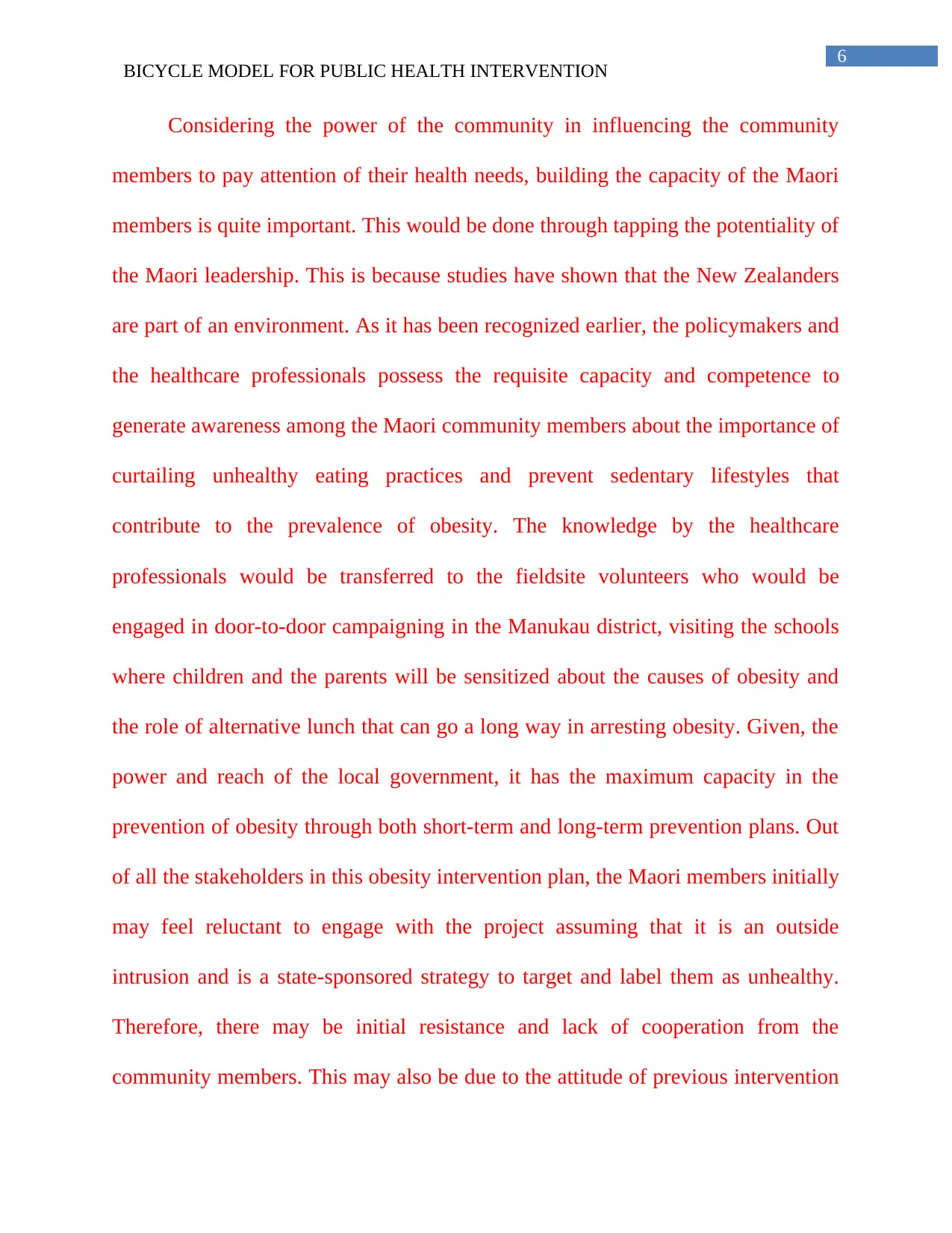
6
BICYCLE MODEL FOR PUBLIC HEALTH INTERVENTION
Considering the power of the community in influencing the community
members to pay attention of their health needs, building the capacity of the Maori
members is quite important. This would be done through tapping the potentiality of
the Maori leadership. This is because studies have shown that the New Zealanders
are part of an environment. As it has been recognized earlier, the policymakers and
the healthcare professionals possess the requisite capacity and competence to
generate awareness among the Maori community members about the importance of
curtailing unhealthy eating practices and prevent sedentary lifestyles that
contribute to the prevalence of obesity. The knowledge by the healthcare
professionals would be transferred to the fieldsite volunteers who would be
engaged in door-to-door campaigning in the Manukau district, visiting the schools
where children and the parents will be sensitized about the causes of obesity and
the role of alternative lunch that can go a long way in arresting obesity. Given, the
power and reach of the local government, it has the maximum capacity in the
prevention of obesity through both short-term and long-term prevention plans. Out
of all the stakeholders in this obesity intervention plan, the Maori members initially
may feel reluctant to engage with the project assuming that it is an outside
intrusion and is a state-sponsored strategy to target and label them as unhealthy.
Therefore, there may be initial resistance and lack of cooperation from the
community members. This may also be due to the attitude of previous intervention
BICYCLE MODEL FOR PUBLIC HEALTH INTERVENTION
Considering the power of the community in influencing the community
members to pay attention of their health needs, building the capacity of the Maori
members is quite important. This would be done through tapping the potentiality of
the Maori leadership. This is because studies have shown that the New Zealanders
are part of an environment. As it has been recognized earlier, the policymakers and
the healthcare professionals possess the requisite capacity and competence to
generate awareness among the Maori community members about the importance of
curtailing unhealthy eating practices and prevent sedentary lifestyles that
contribute to the prevalence of obesity. The knowledge by the healthcare
professionals would be transferred to the fieldsite volunteers who would be
engaged in door-to-door campaigning in the Manukau district, visiting the schools
where children and the parents will be sensitized about the causes of obesity and
the role of alternative lunch that can go a long way in arresting obesity. Given, the
power and reach of the local government, it has the maximum capacity in the
prevention of obesity through both short-term and long-term prevention plans. Out
of all the stakeholders in this obesity intervention plan, the Maori members initially
may feel reluctant to engage with the project assuming that it is an outside
intrusion and is a state-sponsored strategy to target and label them as unhealthy.
Therefore, there may be initial resistance and lack of cooperation from the
community members. This may also be due to the attitude of previous intervention
Paraphrase This Document
Need a fresh take? Get an instant paraphrase of this document with our AI Paraphraser
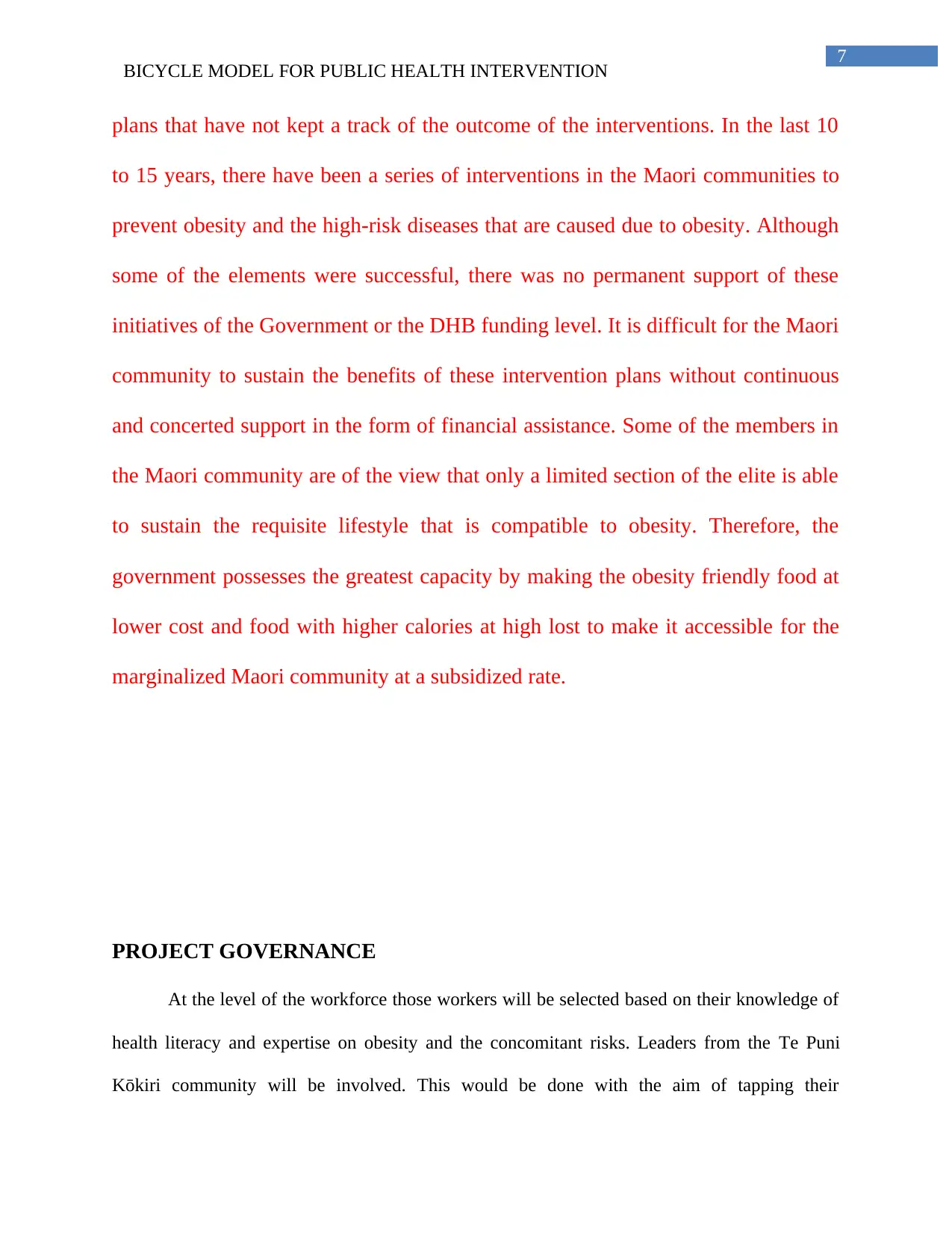
7
BICYCLE MODEL FOR PUBLIC HEALTH INTERVENTION
plans that have not kept a track of the outcome of the interventions. In the last 10
to 15 years, there have been a series of interventions in the Maori communities to
prevent obesity and the high-risk diseases that are caused due to obesity. Although
some of the elements were successful, there was no permanent support of these
initiatives of the Government or the DHB funding level. It is difficult for the Maori
community to sustain the benefits of these intervention plans without continuous
and concerted support in the form of financial assistance. Some of the members in
the Maori community are of the view that only a limited section of the elite is able
to sustain the requisite lifestyle that is compatible to obesity. Therefore, the
government possesses the greatest capacity by making the obesity friendly food at
lower cost and food with higher calories at high lost to make it accessible for the
marginalized Maori community at a subsidized rate.
PROJECT GOVERNANCE
At the level of the workforce those workers will be selected based on their knowledge of
health literacy and expertise on obesity and the concomitant risks. Leaders from the Te Puni
Kōkiri community will be involved. This would be done with the aim of tapping their
BICYCLE MODEL FOR PUBLIC HEALTH INTERVENTION
plans that have not kept a track of the outcome of the interventions. In the last 10
to 15 years, there have been a series of interventions in the Maori communities to
prevent obesity and the high-risk diseases that are caused due to obesity. Although
some of the elements were successful, there was no permanent support of these
initiatives of the Government or the DHB funding level. It is difficult for the Maori
community to sustain the benefits of these intervention plans without continuous
and concerted support in the form of financial assistance. Some of the members in
the Maori community are of the view that only a limited section of the elite is able
to sustain the requisite lifestyle that is compatible to obesity. Therefore, the
government possesses the greatest capacity by making the obesity friendly food at
lower cost and food with higher calories at high lost to make it accessible for the
marginalized Maori community at a subsidized rate.
PROJECT GOVERNANCE
At the level of the workforce those workers will be selected based on their knowledge of
health literacy and expertise on obesity and the concomitant risks. Leaders from the Te Puni
Kōkiri community will be involved. This would be done with the aim of tapping their

8
BICYCLE MODEL FOR PUBLIC HEALTH INTERVENTION
potentiality to lead the workforce in the five different locations of the Manukau District. In
addition, 100 people would be recruited for the healthcare program in the Maori community and
would be directed in five locations in the district (Counties Manukau Health, 2015). The local
government and the municipal would be exhorted to be a part of the healthcare programme for
the entire community. NGOs and the governmental organizations would be targeted for the
welfare of the Maori community. The rationale behind the inclusion of the municipal and the
local schools that would be important for arranging the accommodation for the healthcare
campaigns. Inclusion of the municipal would ensure that there is an additional amenities that
would be utilized in the population gatherings namely the safety and security instruments. This
project would feature working along with the synchronization of the leaders and the elderly
members of the community. The thrust would be to educate them about the effects of obesity in
the community by motivating them to veer towards healthy lifestyle. The Maori community
would accomplish the key role in decision-making regarding the utilization of the resources and
the strategies to be implemented for their healthcare needs. In this case, the intervention that
would be used will be based on evidence existent in the society with the aim of the processes and
the decisions to implement in the process. The local government and the municipal officers
would be involved through community prospect, facilitation of the contribution for all the service
providers, including the training personnel in the promotional event and intensifying the
healthcare infrastructure of the local healthcare facilities.
All the above mentioned stakeholders will be part of the advisory team who will lead the
project and will look into the initiation, governance and the successful implementation of the
intervention plan. In addition to the above mentioned stakeholders there will be sponsors
namelycompanies that are known for their obesity friendly food products. Spinsorship will be
BICYCLE MODEL FOR PUBLIC HEALTH INTERVENTION
potentiality to lead the workforce in the five different locations of the Manukau District. In
addition, 100 people would be recruited for the healthcare program in the Maori community and
would be directed in five locations in the district (Counties Manukau Health, 2015). The local
government and the municipal would be exhorted to be a part of the healthcare programme for
the entire community. NGOs and the governmental organizations would be targeted for the
welfare of the Maori community. The rationale behind the inclusion of the municipal and the
local schools that would be important for arranging the accommodation for the healthcare
campaigns. Inclusion of the municipal would ensure that there is an additional amenities that
would be utilized in the population gatherings namely the safety and security instruments. This
project would feature working along with the synchronization of the leaders and the elderly
members of the community. The thrust would be to educate them about the effects of obesity in
the community by motivating them to veer towards healthy lifestyle. The Maori community
would accomplish the key role in decision-making regarding the utilization of the resources and
the strategies to be implemented for their healthcare needs. In this case, the intervention that
would be used will be based on evidence existent in the society with the aim of the processes and
the decisions to implement in the process. The local government and the municipal officers
would be involved through community prospect, facilitation of the contribution for all the service
providers, including the training personnel in the promotional event and intensifying the
healthcare infrastructure of the local healthcare facilities.
All the above mentioned stakeholders will be part of the advisory team who will lead the
project and will look into the initiation, governance and the successful implementation of the
intervention plan. In addition to the above mentioned stakeholders there will be sponsors
namelycompanies that are known for their obesity friendly food products. Spinsorship will be
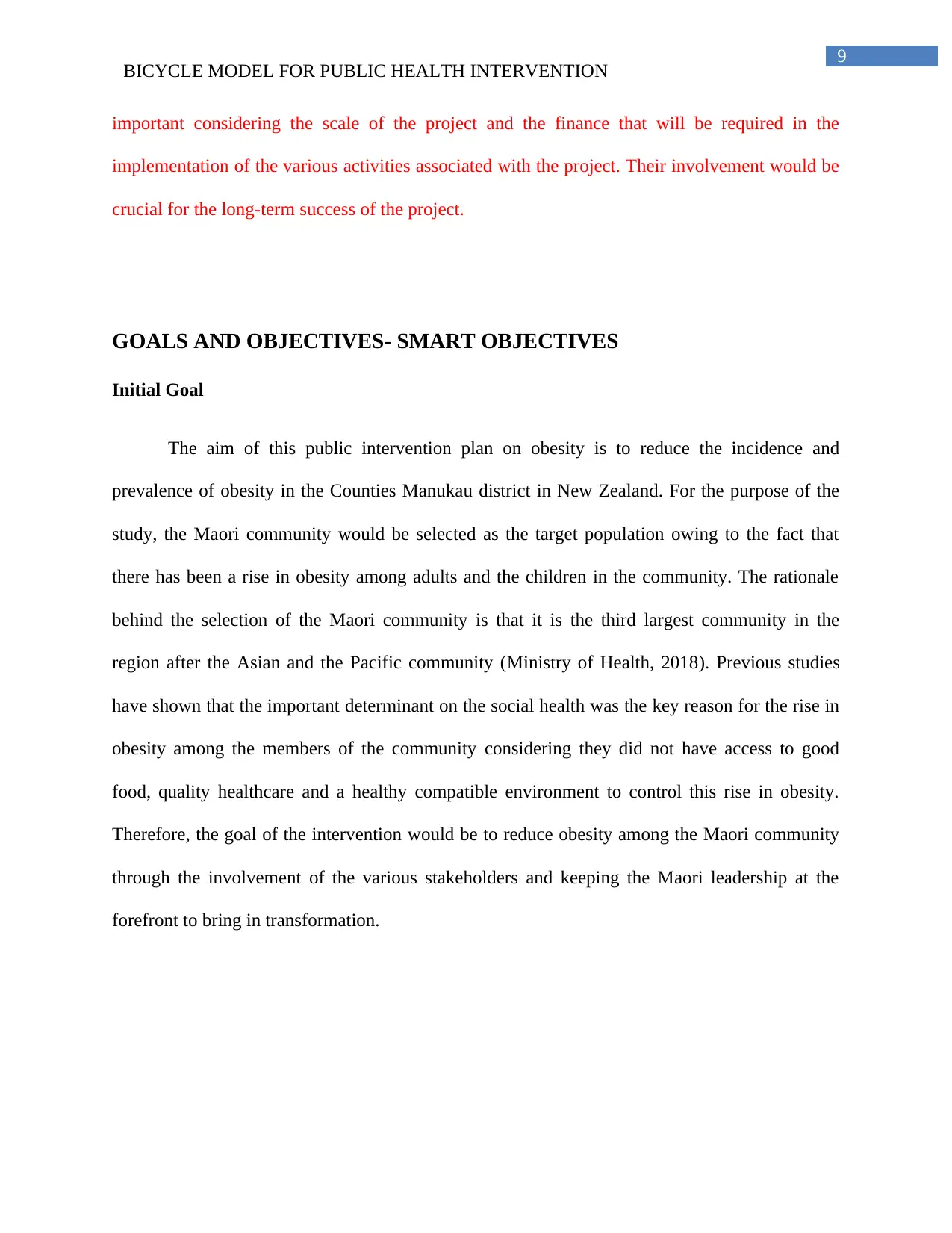
9
BICYCLE MODEL FOR PUBLIC HEALTH INTERVENTION
important considering the scale of the project and the finance that will be required in the
implementation of the various activities associated with the project. Their involvement would be
crucial for the long-term success of the project.
GOALS AND OBJECTIVES- SMART OBJECTIVES
Initial Goal
The aim of this public intervention plan on obesity is to reduce the incidence and
prevalence of obesity in the Counties Manukau district in New Zealand. For the purpose of the
study, the Maori community would be selected as the target population owing to the fact that
there has been a rise in obesity among adults and the children in the community. The rationale
behind the selection of the Maori community is that it is the third largest community in the
region after the Asian and the Pacific community (Ministry of Health, 2018). Previous studies
have shown that the important determinant on the social health was the key reason for the rise in
obesity among the members of the community considering they did not have access to good
food, quality healthcare and a healthy compatible environment to control this rise in obesity.
Therefore, the goal of the intervention would be to reduce obesity among the Maori community
through the involvement of the various stakeholders and keeping the Maori leadership at the
forefront to bring in transformation.
BICYCLE MODEL FOR PUBLIC HEALTH INTERVENTION
important considering the scale of the project and the finance that will be required in the
implementation of the various activities associated with the project. Their involvement would be
crucial for the long-term success of the project.
GOALS AND OBJECTIVES- SMART OBJECTIVES
Initial Goal
The aim of this public intervention plan on obesity is to reduce the incidence and
prevalence of obesity in the Counties Manukau district in New Zealand. For the purpose of the
study, the Maori community would be selected as the target population owing to the fact that
there has been a rise in obesity among adults and the children in the community. The rationale
behind the selection of the Maori community is that it is the third largest community in the
region after the Asian and the Pacific community (Ministry of Health, 2018). Previous studies
have shown that the important determinant on the social health was the key reason for the rise in
obesity among the members of the community considering they did not have access to good
food, quality healthcare and a healthy compatible environment to control this rise in obesity.
Therefore, the goal of the intervention would be to reduce obesity among the Maori community
through the involvement of the various stakeholders and keeping the Maori leadership at the
forefront to bring in transformation.
Secure Best Marks with AI Grader
Need help grading? Try our AI Grader for instant feedback on your assignments.

10
BICYCLE MODEL FOR PUBLIC HEALTH INTERVENTION
1. Specific
As stated earlier, the objective would be reduce and the prevent obesity among the
members of the Maori community. This would be done through collaborating with the different
stakeholders namely the Maori community, the healthcare workers operational in the Manukau
distrust, people who would be involved in the in the promotional campaign, the policy makers,
employees working in the healthcare facilities, local government, ministry of healthcare, labour
and the different profitable and non-profitable organizations (CDC, 2018). I seek to implement
the plan from June as the need assessment and identification of the problem has already been
completed. This s is a goal considering the veracity of obesity identified through the attributable
effects and the costs of overweight and obesity and the price of not doing anything. One
objective would be to reduce the intake of sugar and sweetened beverages among the Maori
community members by 50 % within one year. The second objective would be to increase the
proportion of days during which the at least 30 minutes of exercise would be taken by the
community members by 20 per cent by 2020. Another goal for preventing obesity would be
imposing higher tax on the food products that contribute to obesity thereby curtailing the
consumption of such products by the year 2020.
2. Measurable
BICYCLE MODEL FOR PUBLIC HEALTH INTERVENTION
1. Specific
As stated earlier, the objective would be reduce and the prevent obesity among the
members of the Maori community. This would be done through collaborating with the different
stakeholders namely the Maori community, the healthcare workers operational in the Manukau
distrust, people who would be involved in the in the promotional campaign, the policy makers,
employees working in the healthcare facilities, local government, ministry of healthcare, labour
and the different profitable and non-profitable organizations (CDC, 2018). I seek to implement
the plan from June as the need assessment and identification of the problem has already been
completed. This s is a goal considering the veracity of obesity identified through the attributable
effects and the costs of overweight and obesity and the price of not doing anything. One
objective would be to reduce the intake of sugar and sweetened beverages among the Maori
community members by 50 % within one year. The second objective would be to increase the
proportion of days during which the at least 30 minutes of exercise would be taken by the
community members by 20 per cent by 2020. Another goal for preventing obesity would be
imposing higher tax on the food products that contribute to obesity thereby curtailing the
consumption of such products by the year 2020.
2. Measurable
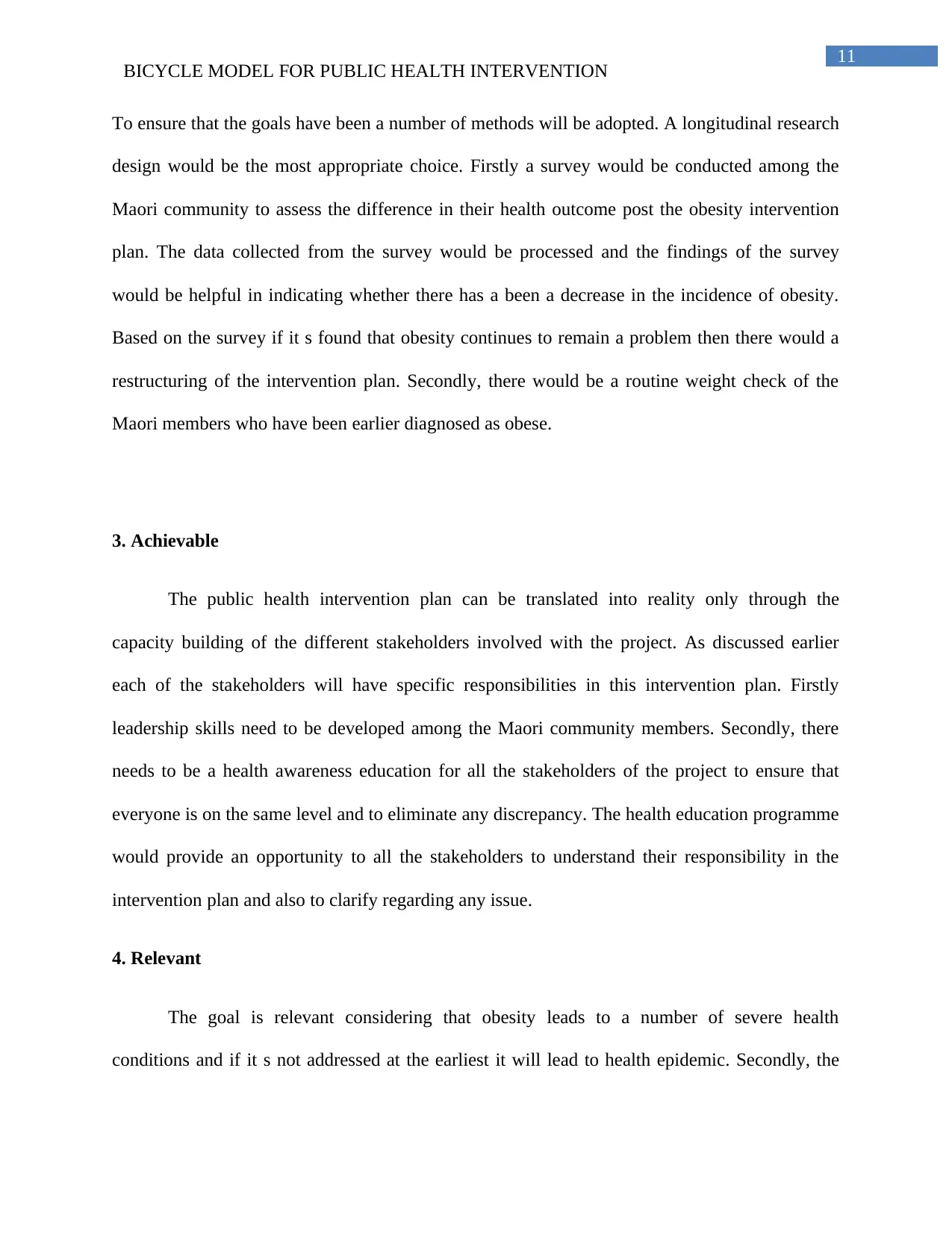
11
BICYCLE MODEL FOR PUBLIC HEALTH INTERVENTION
To ensure that the goals have been a number of methods will be adopted. A longitudinal research
design would be the most appropriate choice. Firstly a survey would be conducted among the
Maori community to assess the difference in their health outcome post the obesity intervention
plan. The data collected from the survey would be processed and the findings of the survey
would be helpful in indicating whether there has a been a decrease in the incidence of obesity.
Based on the survey if it s found that obesity continues to remain a problem then there would a
restructuring of the intervention plan. Secondly, there would be a routine weight check of the
Maori members who have been earlier diagnosed as obese.
3. Achievable
The public health intervention plan can be translated into reality only through the
capacity building of the different stakeholders involved with the project. As discussed earlier
each of the stakeholders will have specific responsibilities in this intervention plan. Firstly
leadership skills need to be developed among the Maori community members. Secondly, there
needs to be a health awareness education for all the stakeholders of the project to ensure that
everyone is on the same level and to eliminate any discrepancy. The health education programme
would provide an opportunity to all the stakeholders to understand their responsibility in the
intervention plan and also to clarify regarding any issue.
4. Relevant
The goal is relevant considering that obesity leads to a number of severe health
conditions and if it s not addressed at the earliest it will lead to health epidemic. Secondly, the
BICYCLE MODEL FOR PUBLIC HEALTH INTERVENTION
To ensure that the goals have been a number of methods will be adopted. A longitudinal research
design would be the most appropriate choice. Firstly a survey would be conducted among the
Maori community to assess the difference in their health outcome post the obesity intervention
plan. The data collected from the survey would be processed and the findings of the survey
would be helpful in indicating whether there has a been a decrease in the incidence of obesity.
Based on the survey if it s found that obesity continues to remain a problem then there would a
restructuring of the intervention plan. Secondly, there would be a routine weight check of the
Maori members who have been earlier diagnosed as obese.
3. Achievable
The public health intervention plan can be translated into reality only through the
capacity building of the different stakeholders involved with the project. As discussed earlier
each of the stakeholders will have specific responsibilities in this intervention plan. Firstly
leadership skills need to be developed among the Maori community members. Secondly, there
needs to be a health awareness education for all the stakeholders of the project to ensure that
everyone is on the same level and to eliminate any discrepancy. The health education programme
would provide an opportunity to all the stakeholders to understand their responsibility in the
intervention plan and also to clarify regarding any issue.
4. Relevant
The goal is relevant considering that obesity leads to a number of severe health
conditions and if it s not addressed at the earliest it will lead to health epidemic. Secondly, the

12
BICYCLE MODEL FOR PUBLIC HEALTH INTERVENTION
Maori community due to lack of education and awareness are not sensitized about the veracity of
obesity. The gola is aligned with the overall objective of the healthcare intervention.
5. Time-bound
The deadline for the public health intervention plan would be six months (June-November). The
time span seems realistic considering that any community model involves the stages of
community assessment, prioritization of the health problems in the community, program
planning and the evaluation of the program. All these process are time consuming and hence, the
six-month time period. It may be extended depending on the progress of the intervention plan.
STRATEGY MIX/INTERVENTION RESEARCH/LOGIC MODELLING
PROBLEM
STATEMENT
High prevalence
and incidence of
obesity among the
Maori community
DETERMINANTS STRATEGY
TYPE
DESCRIPTION RATIONALE OF
THE
STRATEGIES
High cholesterol
and high sugar
Food bought from
home (lunchbox)
Developing
personal skills
Healthy lunchbox
packing education
sessions for
children and
parents. Designed
to be 15 minute
“super sessions” to
coincide with
Earlier
consultation with
parents indicated a
need for skills
development
relative to
selecting and
preparing
BICYCLE MODEL FOR PUBLIC HEALTH INTERVENTION
Maori community due to lack of education and awareness are not sensitized about the veracity of
obesity. The gola is aligned with the overall objective of the healthcare intervention.
5. Time-bound
The deadline for the public health intervention plan would be six months (June-November). The
time span seems realistic considering that any community model involves the stages of
community assessment, prioritization of the health problems in the community, program
planning and the evaluation of the program. All these process are time consuming and hence, the
six-month time period. It may be extended depending on the progress of the intervention plan.
STRATEGY MIX/INTERVENTION RESEARCH/LOGIC MODELLING
PROBLEM
STATEMENT
High prevalence
and incidence of
obesity among the
Maori community
DETERMINANTS STRATEGY
TYPE
DESCRIPTION RATIONALE OF
THE
STRATEGIES
High cholesterol
and high sugar
Food bought from
home (lunchbox)
Developing
personal skills
Healthy lunchbox
packing education
sessions for
children and
parents. Designed
to be 15 minute
“super sessions” to
coincide with
Earlier
consultation with
parents indicated a
need for skills
development
relative to
selecting and
preparing
Paraphrase This Document
Need a fresh take? Get an instant paraphrase of this document with our AI Paraphraser

13
BICYCLE MODEL FOR PUBLIC HEALTH INTERVENTION
children being
collected after
school. Sessions
complemented
with “how to”
fridge magnet
cards that are
marketed to
children as
“parents
homework”.
lunchbox contents
that were
consistent with
dietary guidelines.
Parents expressed
knowledge of best
limited time, food
options as lunch
food and were
amenable to short
education sessions
coinciding with
pick-up.
Lack of adequate
physical activity
due to urbanization
and availability of
new transportation
facilities. This may
be attributed to the
societal and
environmental
changes
Developing
personal skills
The municipal and
the local
government can
promote cycling
among the
community
members. Young
children can be
gifted with cycles
so that they
develop the habit
of cycling and
thereby reduce
weight.
A survey
conducted among
the members of the
Maori community
revealed that they
lack the adequate
finance to afford
bicycle. Therefore,
a little push from
the government
will be a great
initiative.
Another
determinant about
Developing The Maori
community
The Maori
community
BICYCLE MODEL FOR PUBLIC HEALTH INTERVENTION
children being
collected after
school. Sessions
complemented
with “how to”
fridge magnet
cards that are
marketed to
children as
“parents
homework”.
lunchbox contents
that were
consistent with
dietary guidelines.
Parents expressed
knowledge of best
limited time, food
options as lunch
food and were
amenable to short
education sessions
coinciding with
pick-up.
Lack of adequate
physical activity
due to urbanization
and availability of
new transportation
facilities. This may
be attributed to the
societal and
environmental
changes
Developing
personal skills
The municipal and
the local
government can
promote cycling
among the
community
members. Young
children can be
gifted with cycles
so that they
develop the habit
of cycling and
thereby reduce
weight.
A survey
conducted among
the members of the
Maori community
revealed that they
lack the adequate
finance to afford
bicycle. Therefore,
a little push from
the government
will be a great
initiative.
Another
determinant about
Developing The Maori
community
The Maori
community
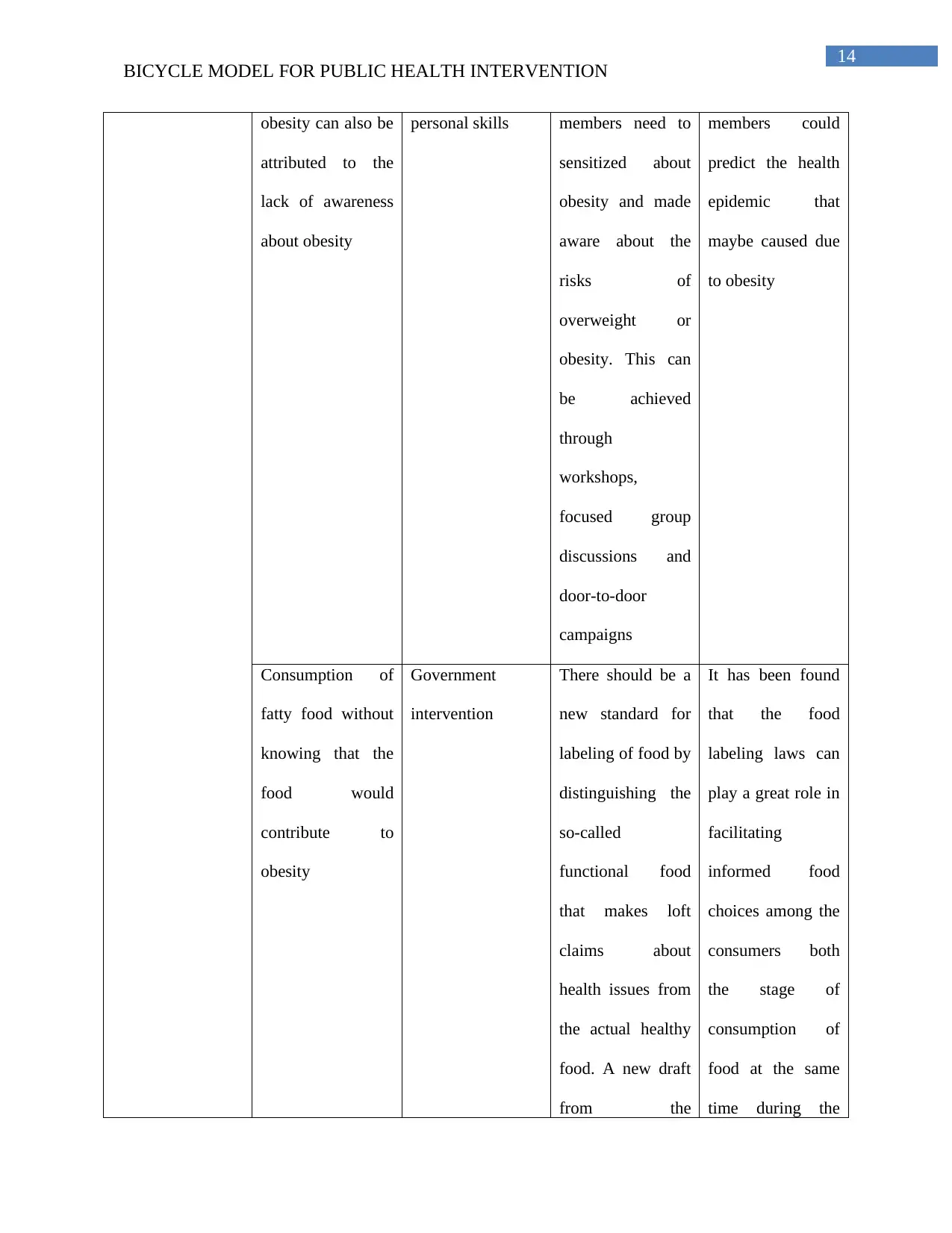
14
BICYCLE MODEL FOR PUBLIC HEALTH INTERVENTION
obesity can also be
attributed to the
lack of awareness
about obesity
personal skills members need to
sensitized about
obesity and made
aware about the
risks of
overweight or
obesity. This can
be achieved
through
workshops,
focused group
discussions and
door-to-door
campaigns
members could
predict the health
epidemic that
maybe caused due
to obesity
Consumption of
fatty food without
knowing that the
food would
contribute to
obesity
Government
intervention
There should be a
new standard for
labeling of food by
distinguishing the
so-called
functional food
that makes loft
claims about
health issues from
the actual healthy
food. A new draft
from the
It has been found
that the food
labeling laws can
play a great role in
facilitating
informed food
choices among the
consumers both
the stage of
consumption of
food at the same
time during the
BICYCLE MODEL FOR PUBLIC HEALTH INTERVENTION
obesity can also be
attributed to the
lack of awareness
about obesity
personal skills members need to
sensitized about
obesity and made
aware about the
risks of
overweight or
obesity. This can
be achieved
through
workshops,
focused group
discussions and
door-to-door
campaigns
members could
predict the health
epidemic that
maybe caused due
to obesity
Consumption of
fatty food without
knowing that the
food would
contribute to
obesity
Government
intervention
There should be a
new standard for
labeling of food by
distinguishing the
so-called
functional food
that makes loft
claims about
health issues from
the actual healthy
food. A new draft
from the
It has been found
that the food
labeling laws can
play a great role in
facilitating
informed food
choices among the
consumers both
the stage of
consumption of
food at the same
time during the
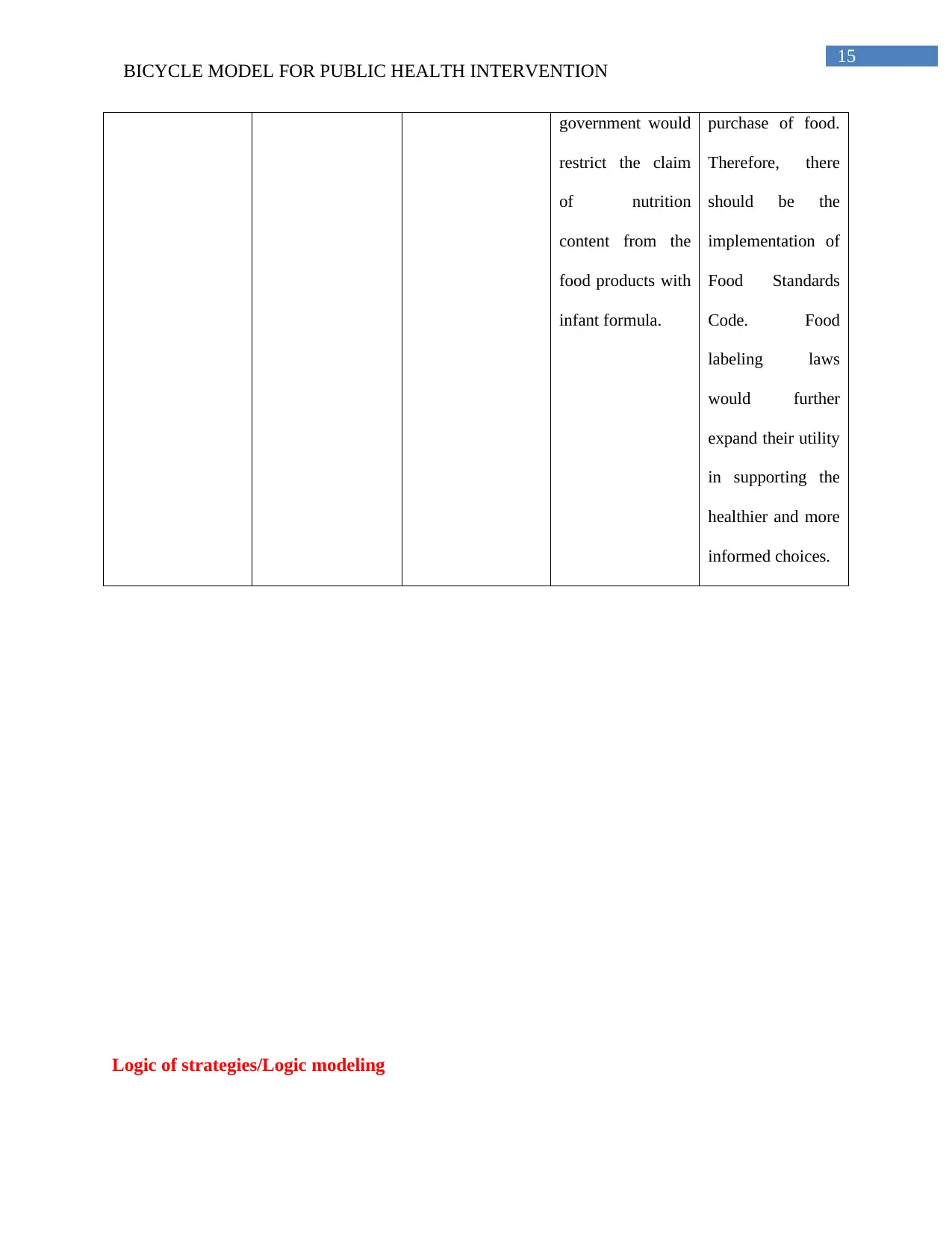
15
BICYCLE MODEL FOR PUBLIC HEALTH INTERVENTION
government would
restrict the claim
of nutrition
content from the
food products with
infant formula.
purchase of food.
Therefore, there
should be the
implementation of
Food Standards
Code. Food
labeling laws
would further
expand their utility
in supporting the
healthier and more
informed choices.
Logic of strategies/Logic modeling
BICYCLE MODEL FOR PUBLIC HEALTH INTERVENTION
government would
restrict the claim
of nutrition
content from the
food products with
infant formula.
purchase of food.
Therefore, there
should be the
implementation of
Food Standards
Code. Food
labeling laws
would further
expand their utility
in supporting the
healthier and more
informed choices.
Logic of strategies/Logic modeling
Secure Best Marks with AI Grader
Need help grading? Try our AI Grader for instant feedback on your assignments.
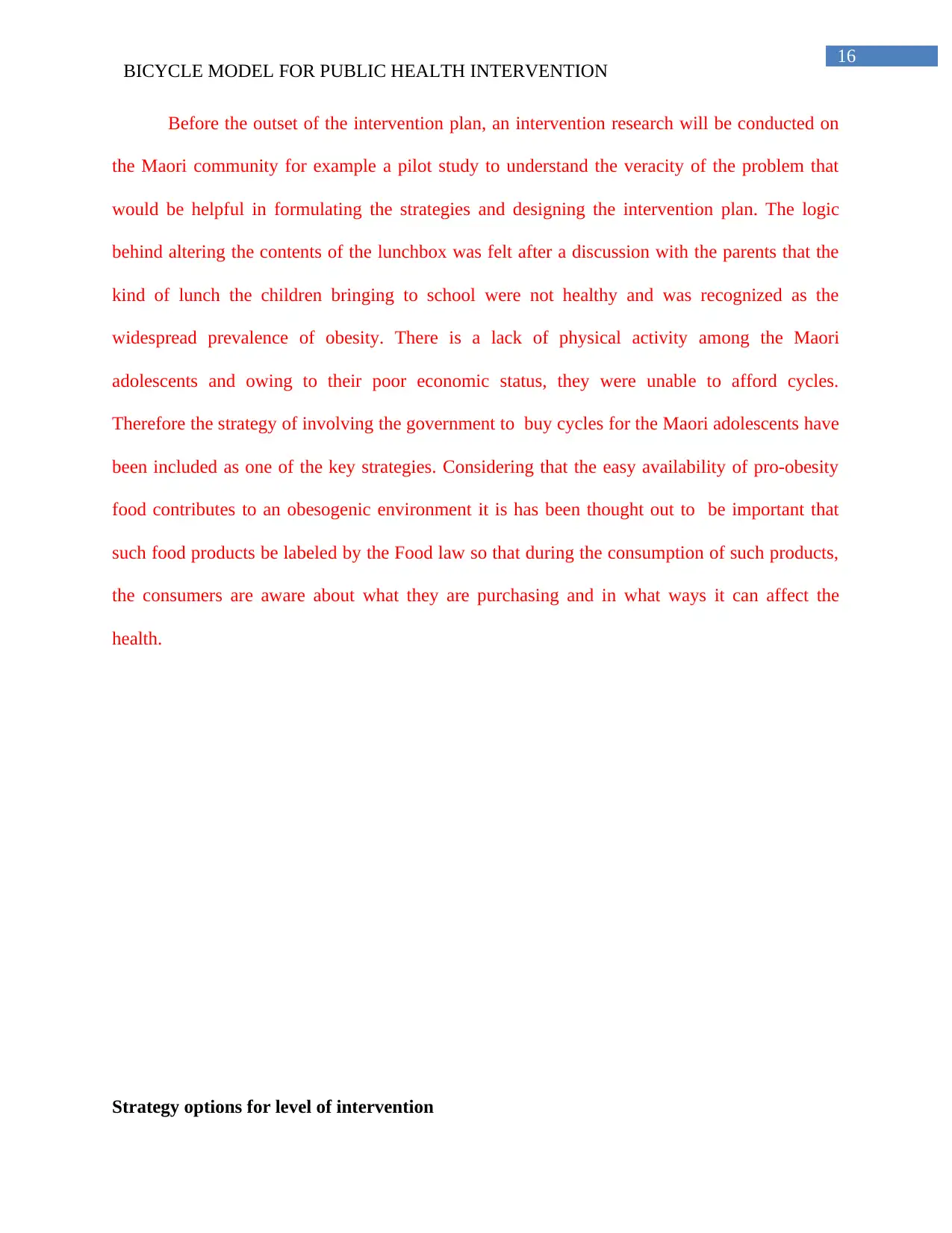
16
BICYCLE MODEL FOR PUBLIC HEALTH INTERVENTION
Before the outset of the intervention plan, an intervention research will be conducted on
the Maori community for example a pilot study to understand the veracity of the problem that
would be helpful in formulating the strategies and designing the intervention plan. The logic
behind altering the contents of the lunchbox was felt after a discussion with the parents that the
kind of lunch the children bringing to school were not healthy and was recognized as the
widespread prevalence of obesity. There is a lack of physical activity among the Maori
adolescents and owing to their poor economic status, they were unable to afford cycles.
Therefore the strategy of involving the government to buy cycles for the Maori adolescents have
been included as one of the key strategies. Considering that the easy availability of pro-obesity
food contributes to an obesogenic environment it is has been thought out to be important that
such food products be labeled by the Food law so that during the consumption of such products,
the consumers are aware about what they are purchasing and in what ways it can affect the
health.
Strategy options for level of intervention
BICYCLE MODEL FOR PUBLIC HEALTH INTERVENTION
Before the outset of the intervention plan, an intervention research will be conducted on
the Maori community for example a pilot study to understand the veracity of the problem that
would be helpful in formulating the strategies and designing the intervention plan. The logic
behind altering the contents of the lunchbox was felt after a discussion with the parents that the
kind of lunch the children bringing to school were not healthy and was recognized as the
widespread prevalence of obesity. There is a lack of physical activity among the Maori
adolescents and owing to their poor economic status, they were unable to afford cycles.
Therefore the strategy of involving the government to buy cycles for the Maori adolescents have
been included as one of the key strategies. Considering that the easy availability of pro-obesity
food contributes to an obesogenic environment it is has been thought out to be important that
such food products be labeled by the Food law so that during the consumption of such products,
the consumers are aware about what they are purchasing and in what ways it can affect the
health.
Strategy options for level of intervention
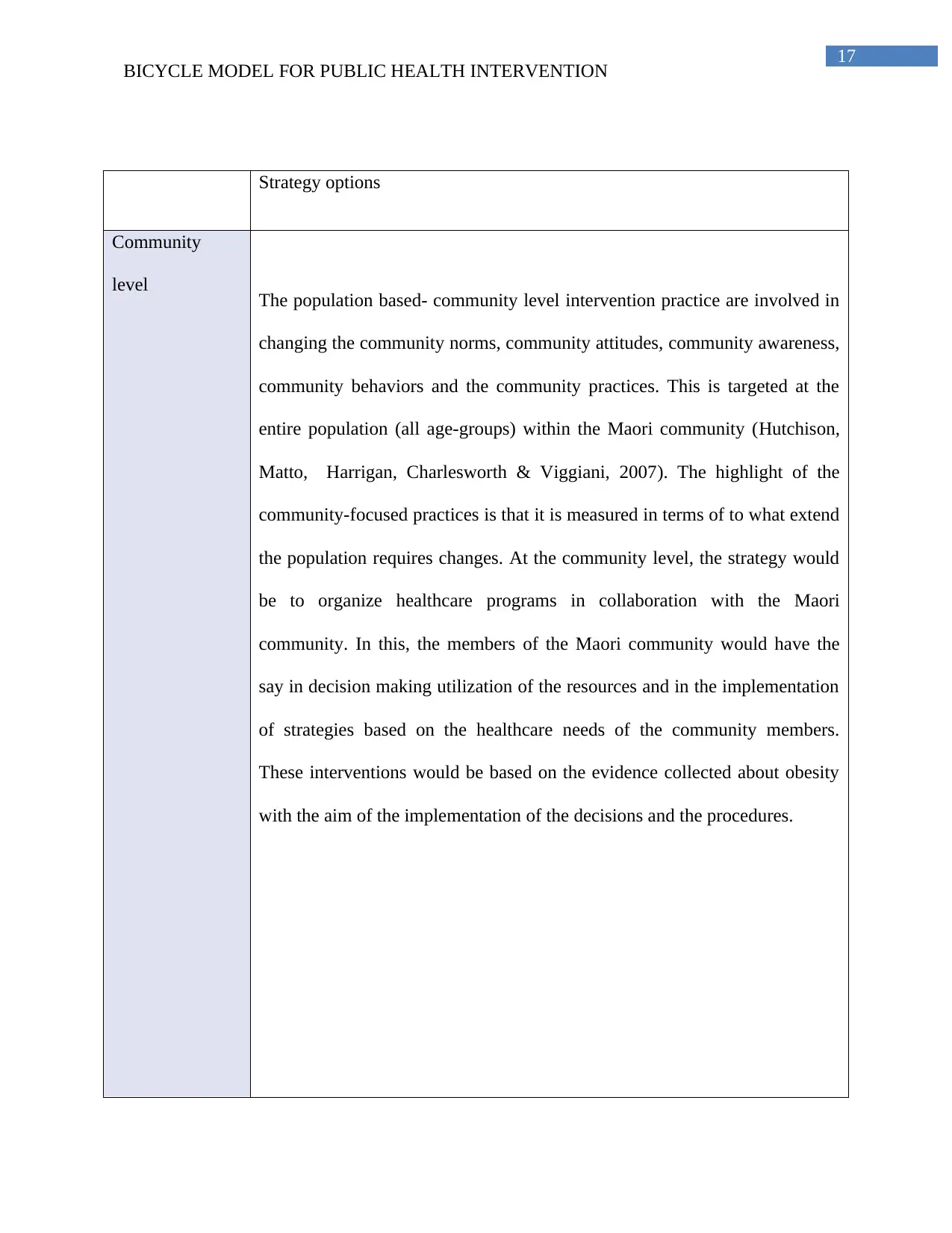
17
BICYCLE MODEL FOR PUBLIC HEALTH INTERVENTION
Strategy options
Community
level The population based- community level intervention practice are involved in
changing the community norms, community attitudes, community awareness,
community behaviors and the community practices. This is targeted at the
entire population (all age-groups) within the Maori community (Hutchison,
Matto, Harrigan, Charlesworth & Viggiani, 2007). The highlight of the
community-focused practices is that it is measured in terms of to what extend
the population requires changes. At the community level, the strategy would
be to organize healthcare programs in collaboration with the Maori
community. In this, the members of the Maori community would have the
say in decision making utilization of the resources and in the implementation
of strategies based on the healthcare needs of the community members.
These interventions would be based on the evidence collected about obesity
with the aim of the implementation of the decisions and the procedures.
BICYCLE MODEL FOR PUBLIC HEALTH INTERVENTION
Strategy options
Community
level The population based- community level intervention practice are involved in
changing the community norms, community attitudes, community awareness,
community behaviors and the community practices. This is targeted at the
entire population (all age-groups) within the Maori community (Hutchison,
Matto, Harrigan, Charlesworth & Viggiani, 2007). The highlight of the
community-focused practices is that it is measured in terms of to what extend
the population requires changes. At the community level, the strategy would
be to organize healthcare programs in collaboration with the Maori
community. In this, the members of the Maori community would have the
say in decision making utilization of the resources and in the implementation
of strategies based on the healthcare needs of the community members.
These interventions would be based on the evidence collected about obesity
with the aim of the implementation of the decisions and the procedures.
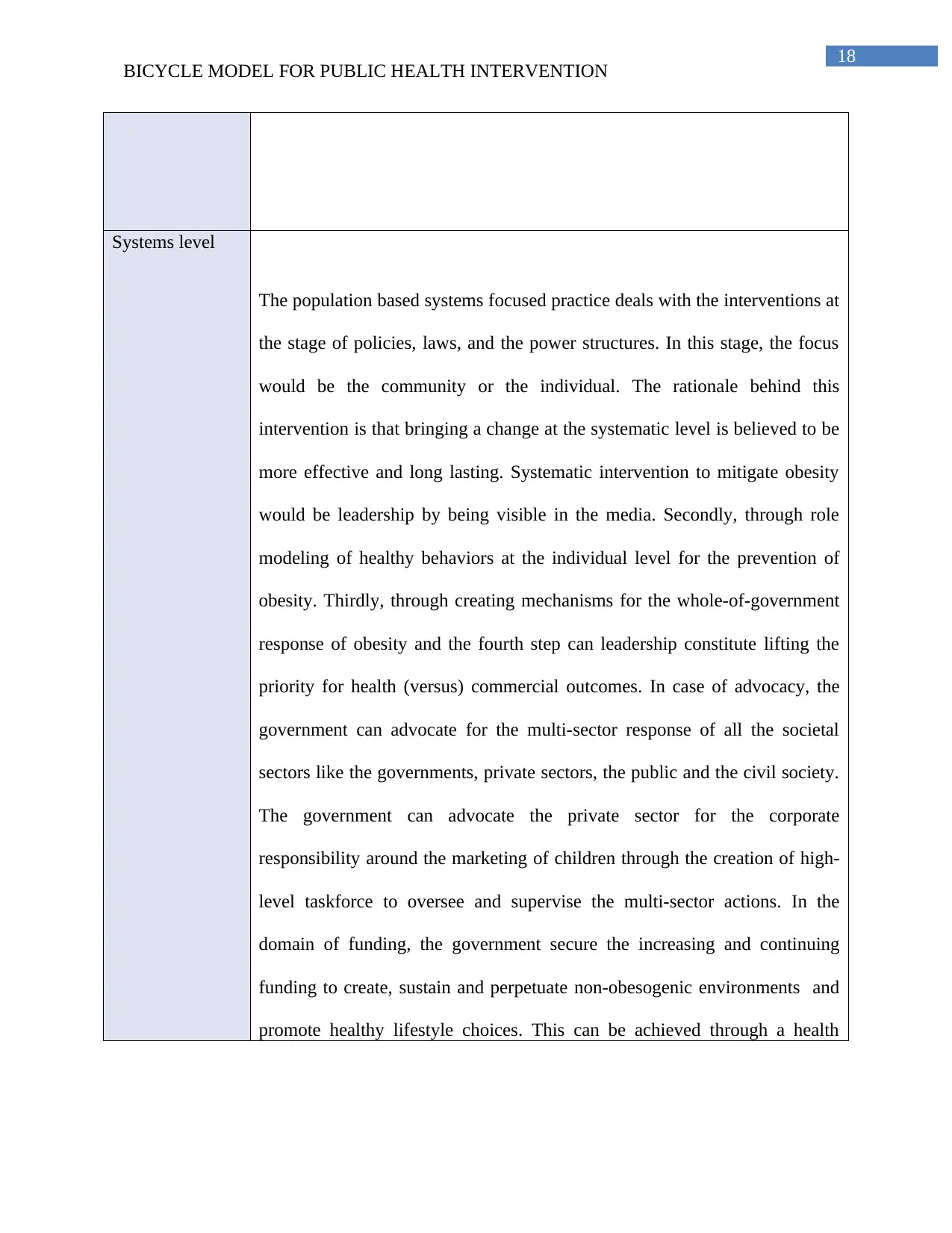
18
BICYCLE MODEL FOR PUBLIC HEALTH INTERVENTION
Systems level
The population based systems focused practice deals with the interventions at
the stage of policies, laws, and the power structures. In this stage, the focus
would be the community or the individual. The rationale behind this
intervention is that bringing a change at the systematic level is believed to be
more effective and long lasting. Systematic intervention to mitigate obesity
would be leadership by being visible in the media. Secondly, through role
modeling of healthy behaviors at the individual level for the prevention of
obesity. Thirdly, through creating mechanisms for the whole-of-government
response of obesity and the fourth step can leadership constitute lifting the
priority for health (versus) commercial outcomes. In case of advocacy, the
government can advocate for the multi-sector response of all the societal
sectors like the governments, private sectors, the public and the civil society.
The government can advocate the private sector for the corporate
responsibility around the marketing of children through the creation of high-
level taskforce to oversee and supervise the multi-sector actions. In the
domain of funding, the government secure the increasing and continuing
funding to create, sustain and perpetuate non-obesogenic environments and
promote healthy lifestyle choices. This can be achieved through a health
BICYCLE MODEL FOR PUBLIC HEALTH INTERVENTION
Systems level
The population based systems focused practice deals with the interventions at
the stage of policies, laws, and the power structures. In this stage, the focus
would be the community or the individual. The rationale behind this
intervention is that bringing a change at the systematic level is believed to be
more effective and long lasting. Systematic intervention to mitigate obesity
would be leadership by being visible in the media. Secondly, through role
modeling of healthy behaviors at the individual level for the prevention of
obesity. Thirdly, through creating mechanisms for the whole-of-government
response of obesity and the fourth step can leadership constitute lifting the
priority for health (versus) commercial outcomes. In case of advocacy, the
government can advocate for the multi-sector response of all the societal
sectors like the governments, private sectors, the public and the civil society.
The government can advocate the private sector for the corporate
responsibility around the marketing of children through the creation of high-
level taskforce to oversee and supervise the multi-sector actions. In the
domain of funding, the government secure the increasing and continuing
funding to create, sustain and perpetuate non-obesogenic environments and
promote healthy lifestyle choices. This can be achieved through a health
Paraphrase This Document
Need a fresh take? Get an instant paraphrase of this document with our AI Paraphraser
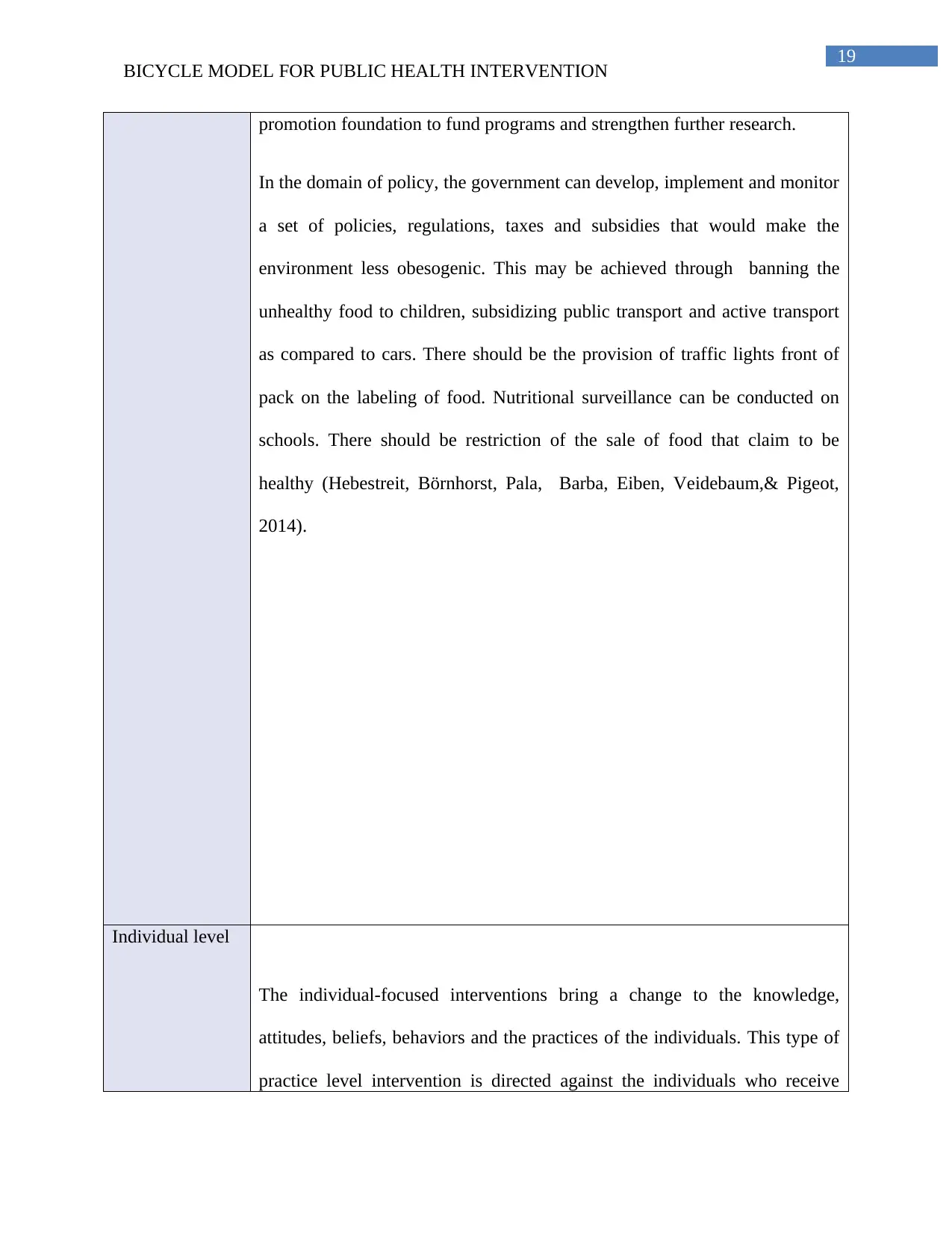
19
BICYCLE MODEL FOR PUBLIC HEALTH INTERVENTION
promotion foundation to fund programs and strengthen further research.
In the domain of policy, the government can develop, implement and monitor
a set of policies, regulations, taxes and subsidies that would make the
environment less obesogenic. This may be achieved through banning the
unhealthy food to children, subsidizing public transport and active transport
as compared to cars. There should be the provision of traffic lights front of
pack on the labeling of food. Nutritional surveillance can be conducted on
schools. There should be restriction of the sale of food that claim to be
healthy (Hebestreit, Börnhorst, Pala, Barba, Eiben, Veidebaum,& Pigeot,
2014).
Individual level
The individual-focused interventions bring a change to the knowledge,
attitudes, beliefs, behaviors and the practices of the individuals. This type of
practice level intervention is directed against the individuals who receive
BICYCLE MODEL FOR PUBLIC HEALTH INTERVENTION
promotion foundation to fund programs and strengthen further research.
In the domain of policy, the government can develop, implement and monitor
a set of policies, regulations, taxes and subsidies that would make the
environment less obesogenic. This may be achieved through banning the
unhealthy food to children, subsidizing public transport and active transport
as compared to cars. There should be the provision of traffic lights front of
pack on the labeling of food. Nutritional surveillance can be conducted on
schools. There should be restriction of the sale of food that claim to be
healthy (Hebestreit, Börnhorst, Pala, Barba, Eiben, Veidebaum,& Pigeot,
2014).
Individual level
The individual-focused interventions bring a change to the knowledge,
attitudes, beliefs, behaviors and the practices of the individuals. This type of
practice level intervention is directed against the individuals who receive
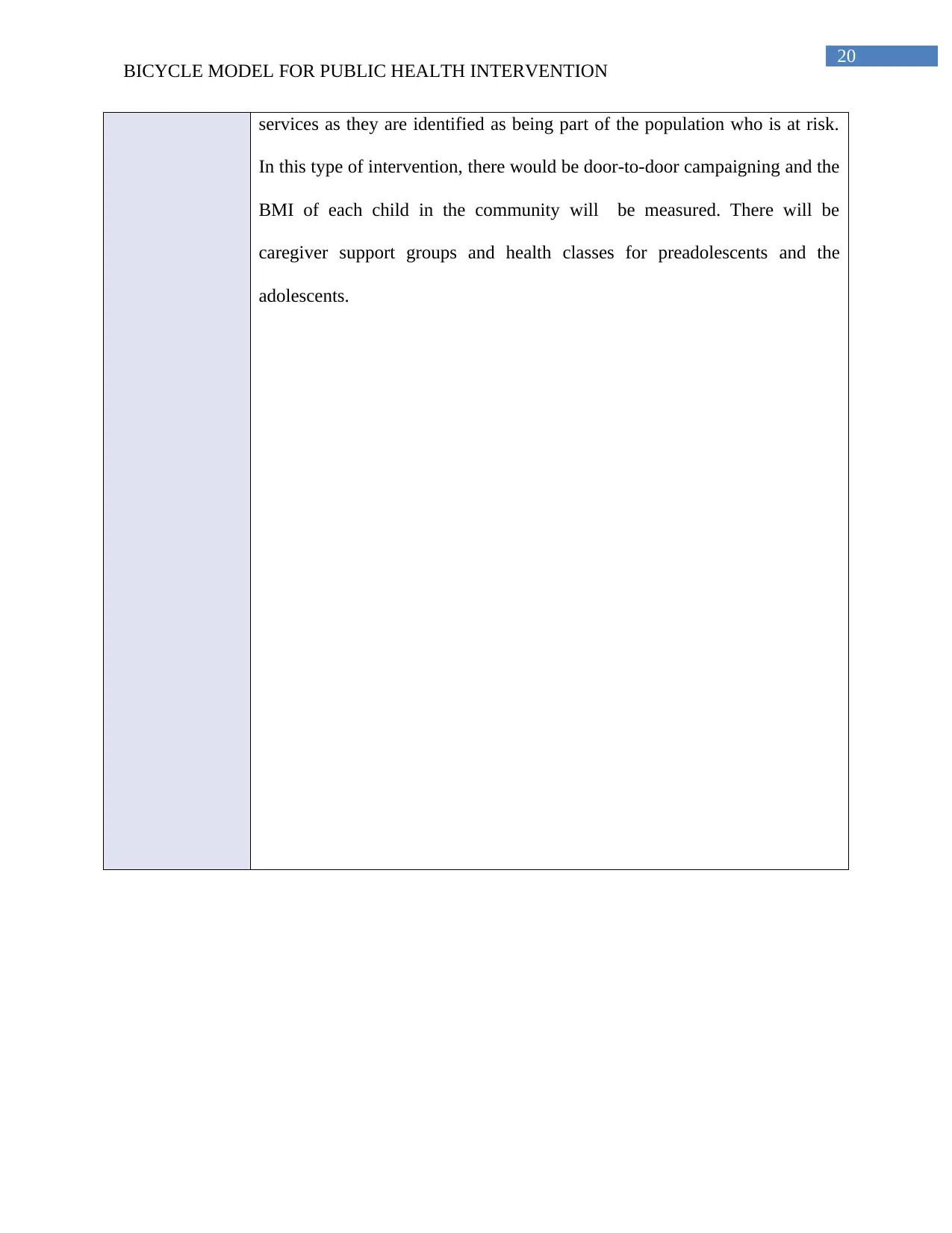
20
BICYCLE MODEL FOR PUBLIC HEALTH INTERVENTION
services as they are identified as being part of the population who is at risk.
In this type of intervention, there would be door-to-door campaigning and the
BMI of each child in the community will be measured. There will be
caregiver support groups and health classes for preadolescents and the
adolescents.
BICYCLE MODEL FOR PUBLIC HEALTH INTERVENTION
services as they are identified as being part of the population who is at risk.
In this type of intervention, there would be door-to-door campaigning and the
BMI of each child in the community will be measured. There will be
caregiver support groups and health classes for preadolescents and the
adolescents.
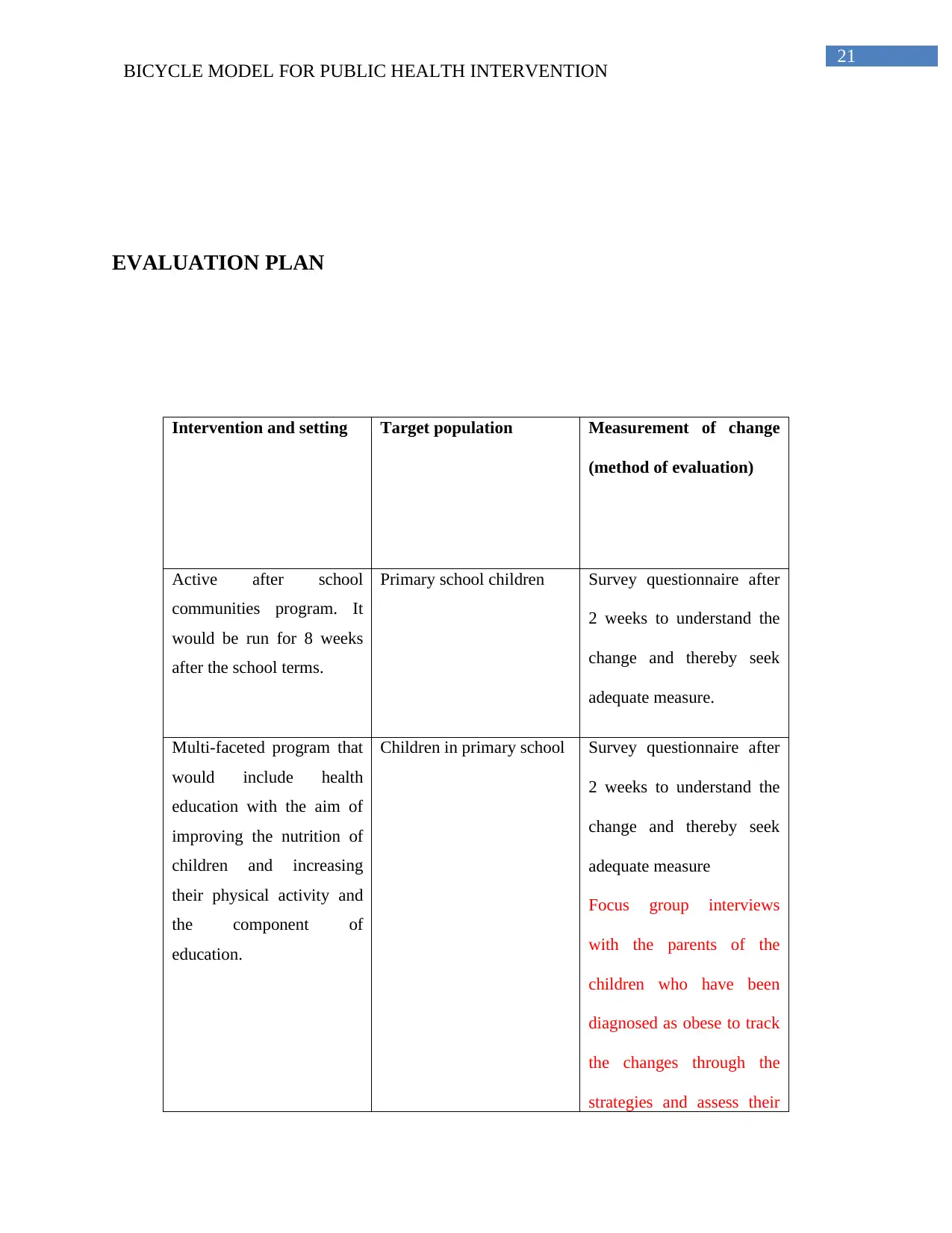
21
BICYCLE MODEL FOR PUBLIC HEALTH INTERVENTION
EVALUATION PLAN
Intervention and setting Target population Measurement of change
(method of evaluation)
Active after school
communities program. It
would be run for 8 weeks
after the school terms.
Primary school children Survey questionnaire after
2 weeks to understand the
change and thereby seek
adequate measure.
Multi-faceted program that
would include health
education with the aim of
improving the nutrition of
children and increasing
their physical activity and
the component of
education.
Children in primary school Survey questionnaire after
2 weeks to understand the
change and thereby seek
adequate measure
Focus group interviews
with the parents of the
children who have been
diagnosed as obese to track
the changes through the
strategies and assess their
BICYCLE MODEL FOR PUBLIC HEALTH INTERVENTION
EVALUATION PLAN
Intervention and setting Target population Measurement of change
(method of evaluation)
Active after school
communities program. It
would be run for 8 weeks
after the school terms.
Primary school children Survey questionnaire after
2 weeks to understand the
change and thereby seek
adequate measure.
Multi-faceted program that
would include health
education with the aim of
improving the nutrition of
children and increasing
their physical activity and
the component of
education.
Children in primary school Survey questionnaire after
2 weeks to understand the
change and thereby seek
adequate measure
Focus group interviews
with the parents of the
children who have been
diagnosed as obese to track
the changes through the
strategies and assess their
Secure Best Marks with AI Grader
Need help grading? Try our AI Grader for instant feedback on your assignments.

22
BICYCLE MODEL FOR PUBLIC HEALTH INTERVENTION
success.
Multi-faceted program that
would include health
education with the aim of
improving the nutrition of
children and increasing
their physical activity
Children in primary school
grade
Survey questionnaire after
2 weeks to understand the
change and thereby seek
adequate measure
Focus group interviews
with the children in the
primary school grade to
understand about the
barriers
Multi-faceted program
targeting obese and
overweight children
Overweight or obese
children aged 7-10 years
Survey questionnaire after
2 weeks to understand the
change and thereby seek
adequate measure.
Qualitative interviewing
and focus group interviews
with the children
Education program to
curtail sedentary lifestyle
Students who are in higher
education
Survey questionnaire after
2 weeks to understand the
change and thereby seek
adequate measure.
Qualitative interview and
focus group discussions
with the children to
understand whether the
education program was
BICYCLE MODEL FOR PUBLIC HEALTH INTERVENTION
success.
Multi-faceted program that
would include health
education with the aim of
improving the nutrition of
children and increasing
their physical activity
Children in primary school
grade
Survey questionnaire after
2 weeks to understand the
change and thereby seek
adequate measure
Focus group interviews
with the children in the
primary school grade to
understand about the
barriers
Multi-faceted program
targeting obese and
overweight children
Overweight or obese
children aged 7-10 years
Survey questionnaire after
2 weeks to understand the
change and thereby seek
adequate measure.
Qualitative interviewing
and focus group interviews
with the children
Education program to
curtail sedentary lifestyle
Students who are in higher
education
Survey questionnaire after
2 weeks to understand the
change and thereby seek
adequate measure.
Qualitative interview and
focus group discussions
with the children to
understand whether the
education program was
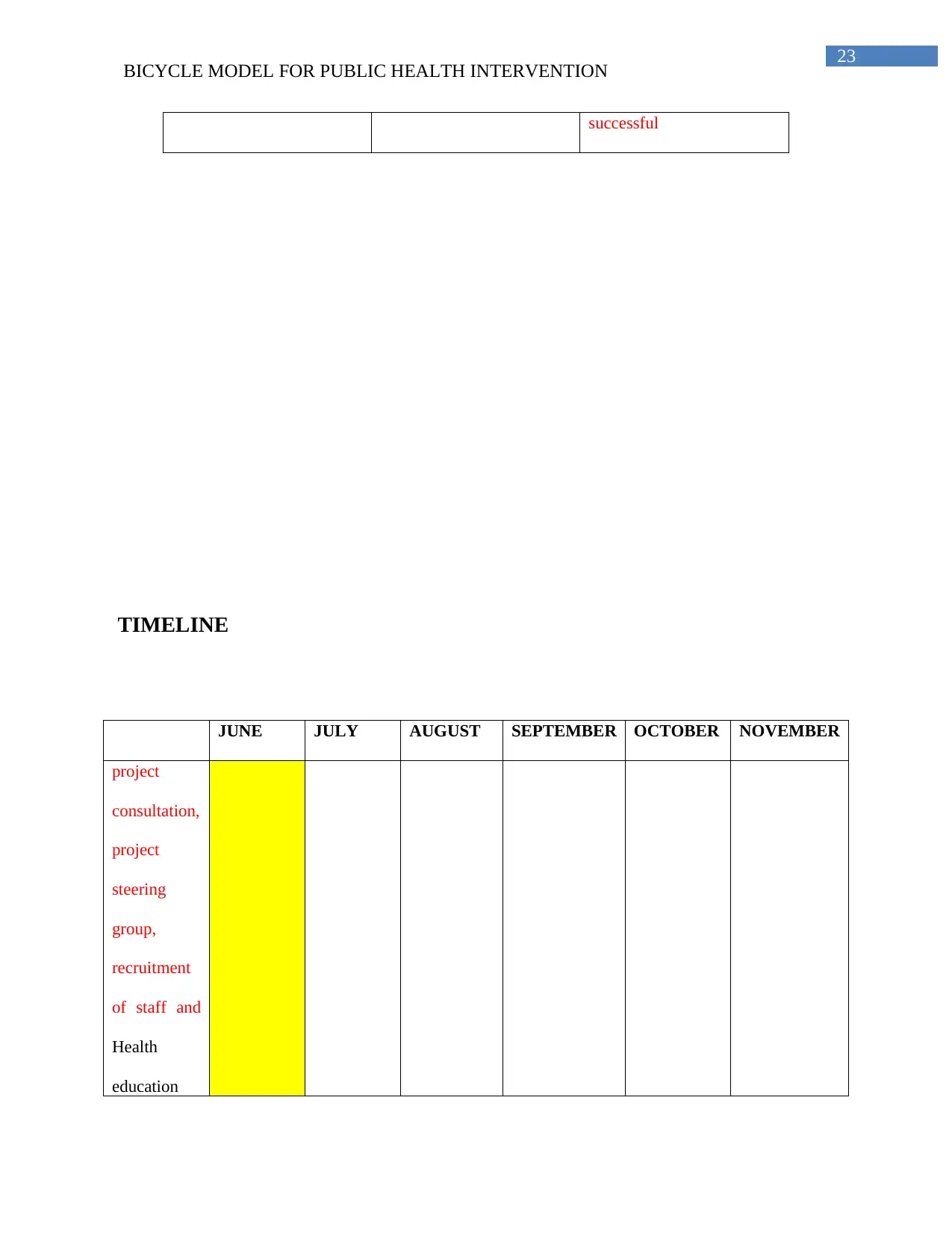
23
BICYCLE MODEL FOR PUBLIC HEALTH INTERVENTION
successful
TIMELINE
JUNE JULY AUGUST SEPTEMBER OCTOBER NOVEMBER
project
consultation,
project
steering
group,
recruitment
of staff and
Health
education
BICYCLE MODEL FOR PUBLIC HEALTH INTERVENTION
successful
TIMELINE
JUNE JULY AUGUST SEPTEMBER OCTOBER NOVEMBER
project
consultation,
project
steering
group,
recruitment
of staff and
Health
education
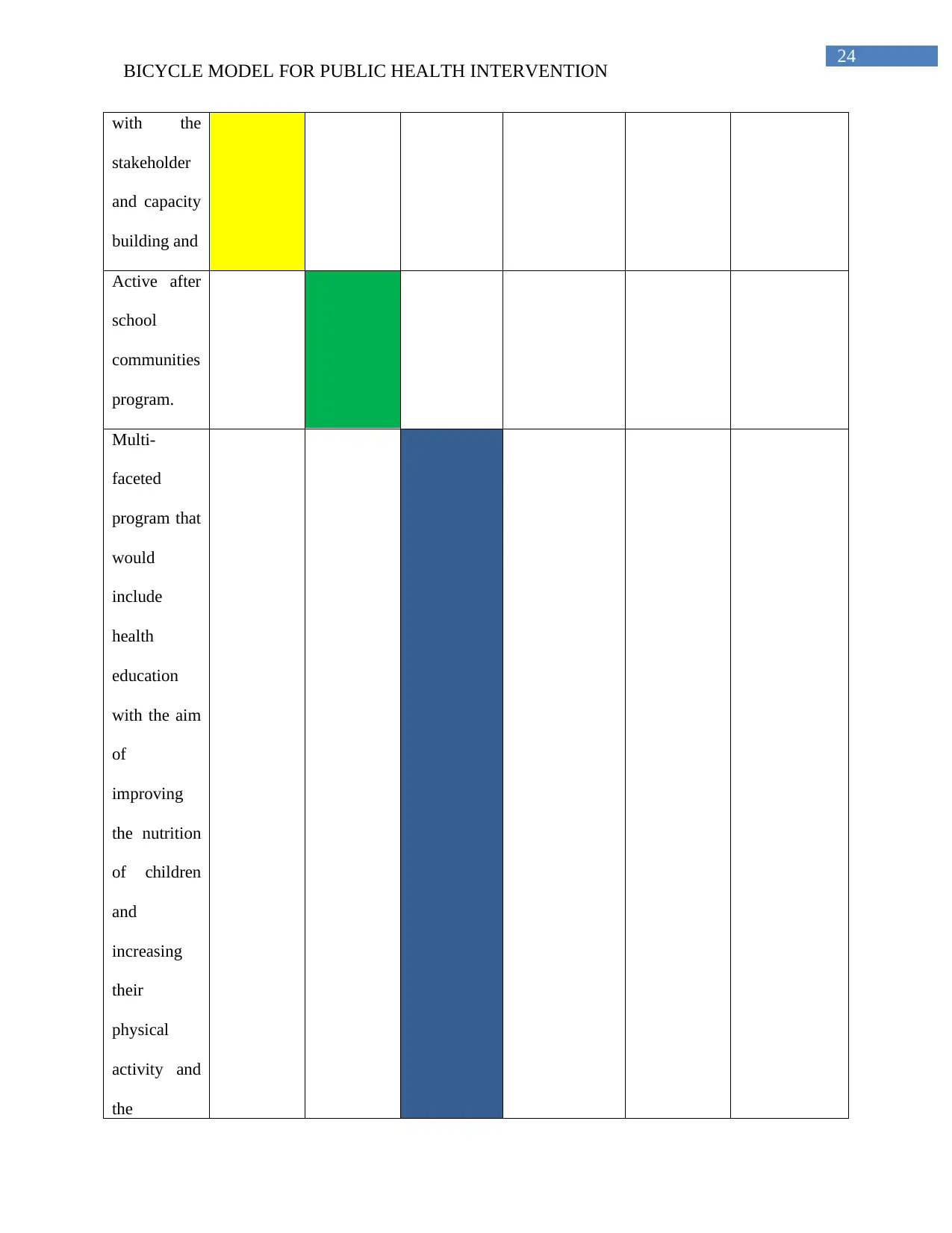
24
BICYCLE MODEL FOR PUBLIC HEALTH INTERVENTION
with the
stakeholder
and capacity
building and
Active after
school
communities
program.
Multi-
faceted
program that
would
include
health
education
with the aim
of
improving
the nutrition
of children
and
increasing
their
physical
activity and
the
BICYCLE MODEL FOR PUBLIC HEALTH INTERVENTION
with the
stakeholder
and capacity
building and
Active after
school
communities
program.
Multi-
faceted
program that
would
include
health
education
with the aim
of
improving
the nutrition
of children
and
increasing
their
physical
activity and
the
Paraphrase This Document
Need a fresh take? Get an instant paraphrase of this document with our AI Paraphraser
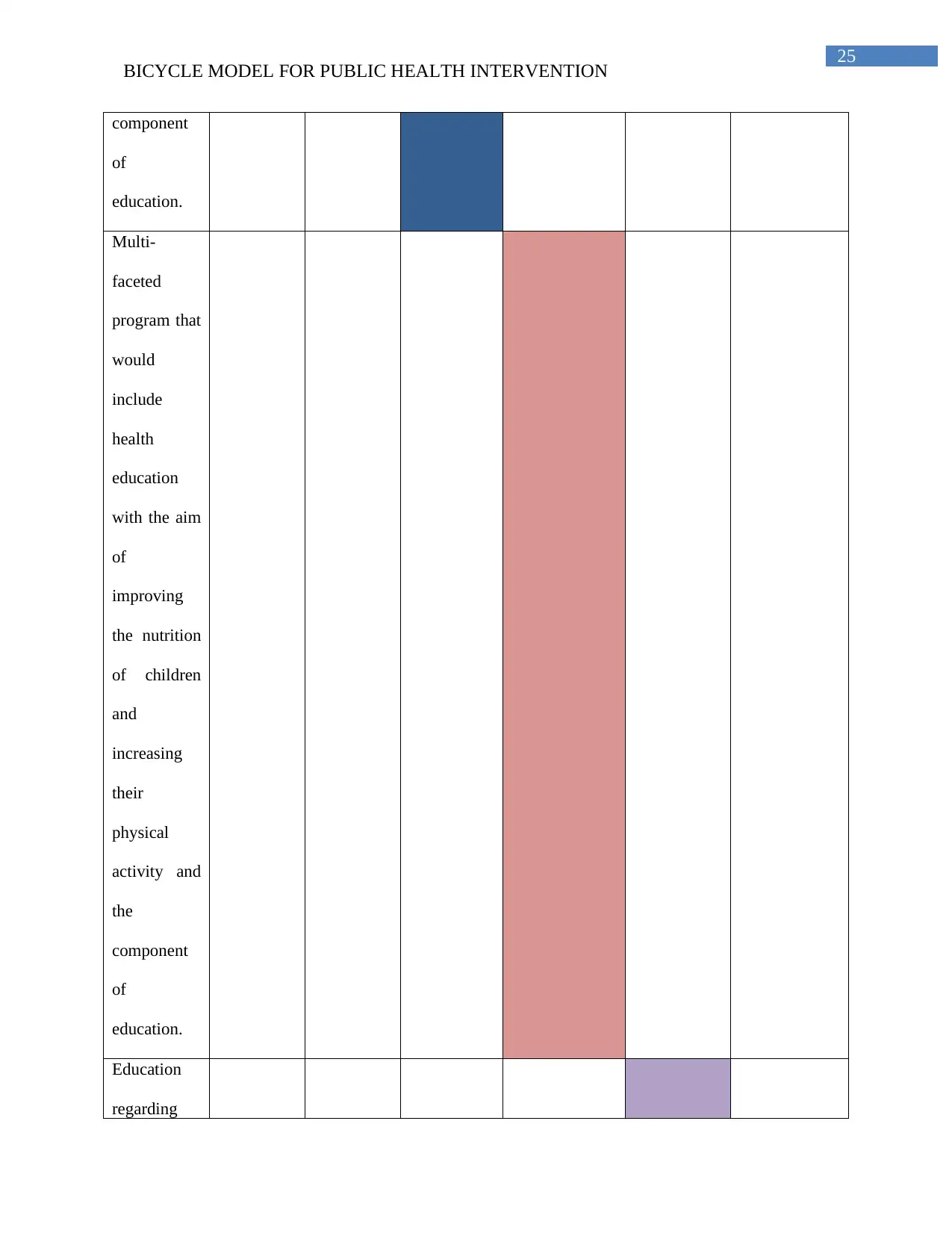
25
BICYCLE MODEL FOR PUBLIC HEALTH INTERVENTION
component
of
education.
Multi-
faceted
program that
would
include
health
education
with the aim
of
improving
the nutrition
of children
and
increasing
their
physical
activity and
the
component
of
education.
Education
regarding
BICYCLE MODEL FOR PUBLIC HEALTH INTERVENTION
component
of
education.
Multi-
faceted
program that
would
include
health
education
with the aim
of
improving
the nutrition
of children
and
increasing
their
physical
activity and
the
component
of
education.
Education
regarding
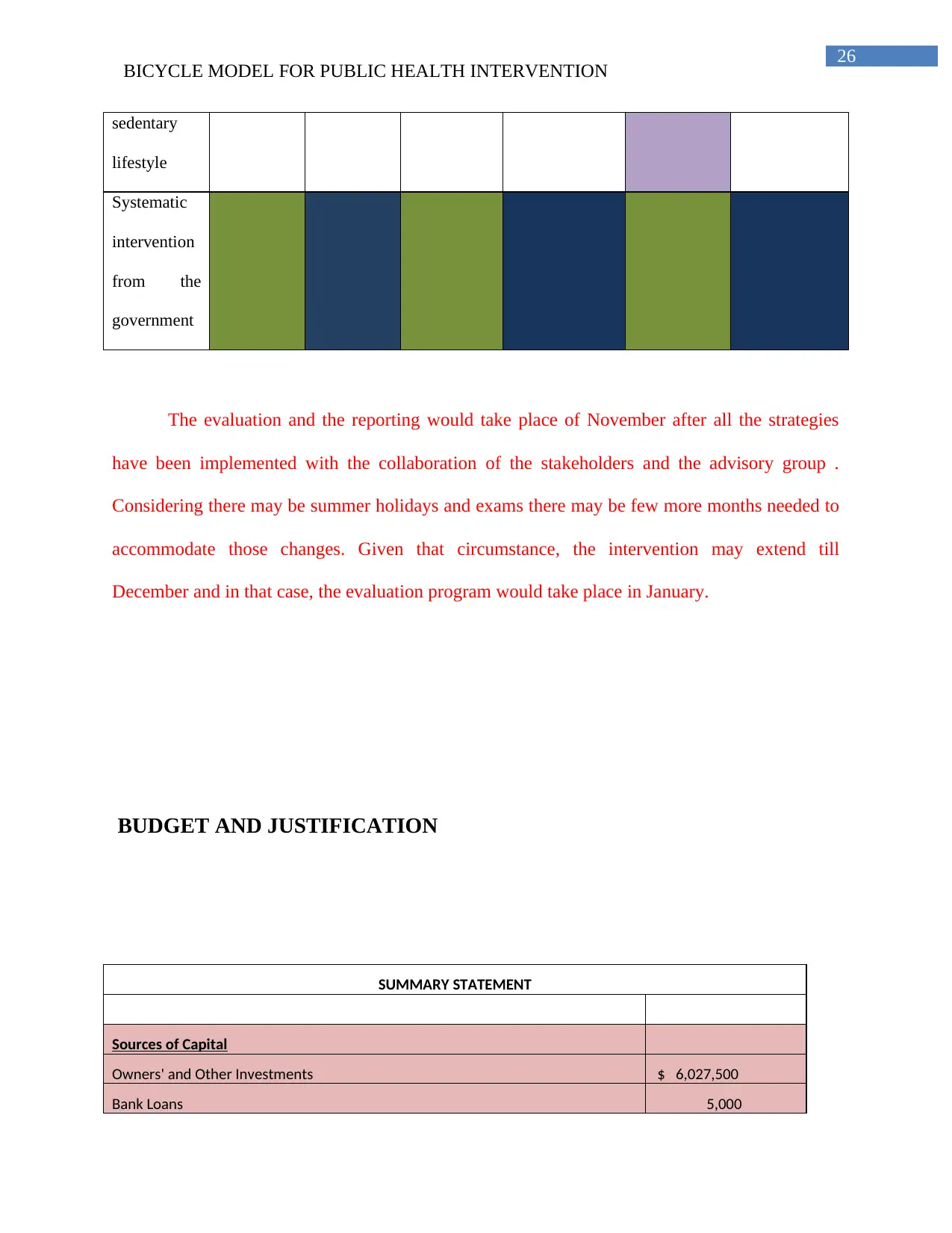
26
BICYCLE MODEL FOR PUBLIC HEALTH INTERVENTION
sedentary
lifestyle
Systematic
intervention
from the
government
The evaluation and the reporting would take place of November after all the strategies
have been implemented with the collaboration of the stakeholders and the advisory group .
Considering there may be summer holidays and exams there may be few more months needed to
accommodate those changes. Given that circumstance, the intervention may extend till
December and in that case, the evaluation program would take place in January.
BUDGET AND JUSTIFICATION
SUMMARY STATEMENT
Sources of Capital
Owners' and Other Investments $ 6,027,500
Bank Loans 5,000
BICYCLE MODEL FOR PUBLIC HEALTH INTERVENTION
sedentary
lifestyle
Systematic
intervention
from the
government
The evaluation and the reporting would take place of November after all the strategies
have been implemented with the collaboration of the stakeholders and the advisory group .
Considering there may be summer holidays and exams there may be few more months needed to
accommodate those changes. Given that circumstance, the intervention may extend till
December and in that case, the evaluation program would take place in January.
BUDGET AND JUSTIFICATION
SUMMARY STATEMENT
Sources of Capital
Owners' and Other Investments $ 6,027,500
Bank Loans 5,000
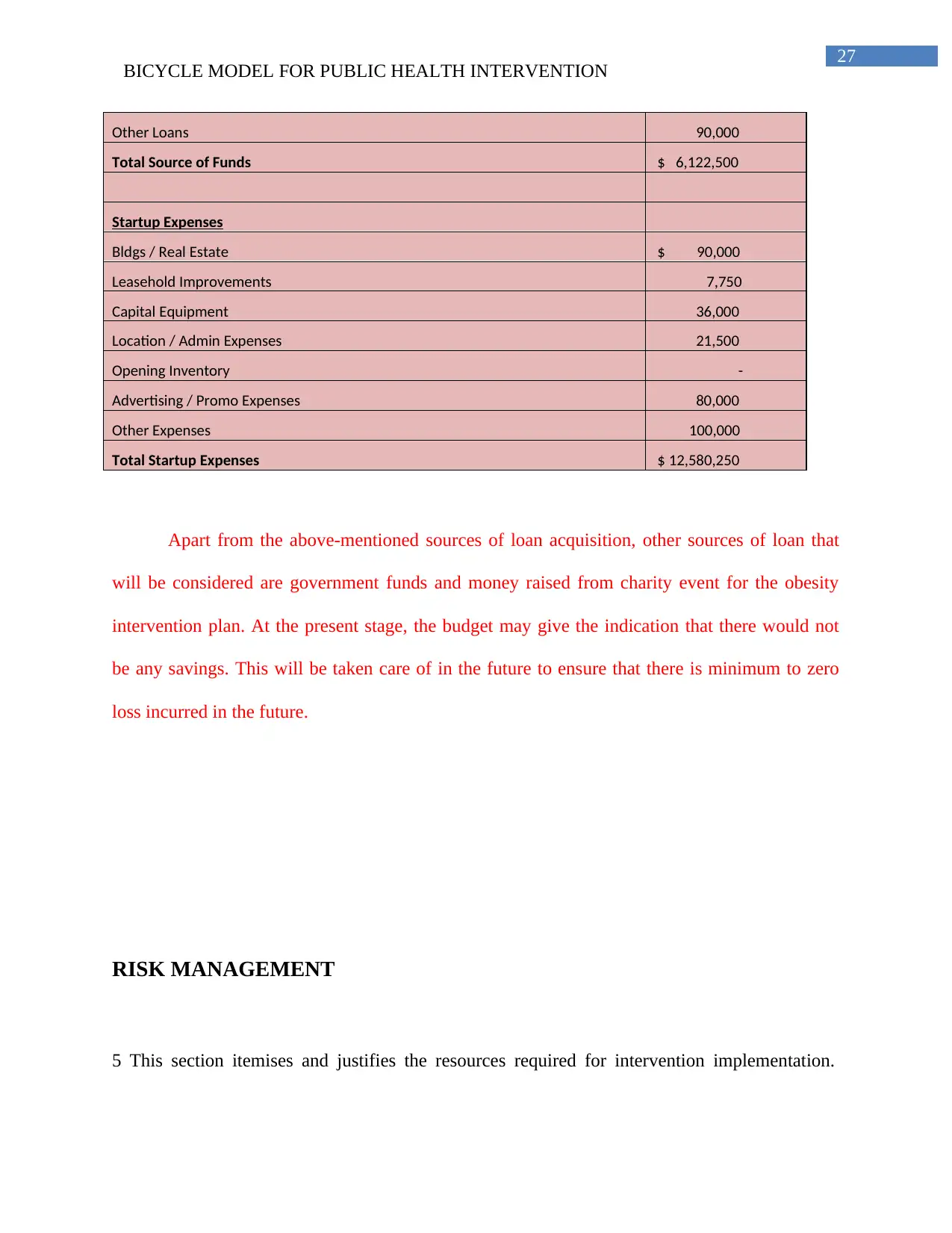
27
BICYCLE MODEL FOR PUBLIC HEALTH INTERVENTION
Other Loans 90,000
Total Source of Funds $ 6,122,500
Startup Expenses
Bldgs / Real Estate $ 90,000
Leasehold Improvements 7,750
Capital Equipment 36,000
Location / Admin Expenses 21,500
Opening Inventory -
Advertising / Promo Expenses 80,000
Other Expenses 100,000
Total Startup Expenses $ 12,580,250
Apart from the above-mentioned sources of loan acquisition, other sources of loan that
will be considered are government funds and money raised from charity event for the obesity
intervention plan. At the present stage, the budget may give the indication that there would not
be any savings. This will be taken care of in the future to ensure that there is minimum to zero
loss incurred in the future.
RISK MANAGEMENT
5 This section itemises and justifies the resources required for intervention implementation.
BICYCLE MODEL FOR PUBLIC HEALTH INTERVENTION
Other Loans 90,000
Total Source of Funds $ 6,122,500
Startup Expenses
Bldgs / Real Estate $ 90,000
Leasehold Improvements 7,750
Capital Equipment 36,000
Location / Admin Expenses 21,500
Opening Inventory -
Advertising / Promo Expenses 80,000
Other Expenses 100,000
Total Startup Expenses $ 12,580,250
Apart from the above-mentioned sources of loan acquisition, other sources of loan that
will be considered are government funds and money raised from charity event for the obesity
intervention plan. At the present stage, the budget may give the indication that there would not
be any savings. This will be taken care of in the future to ensure that there is minimum to zero
loss incurred in the future.
RISK MANAGEMENT
5 This section itemises and justifies the resources required for intervention implementation.
Secure Best Marks with AI Grader
Need help grading? Try our AI Grader for instant feedback on your assignments.
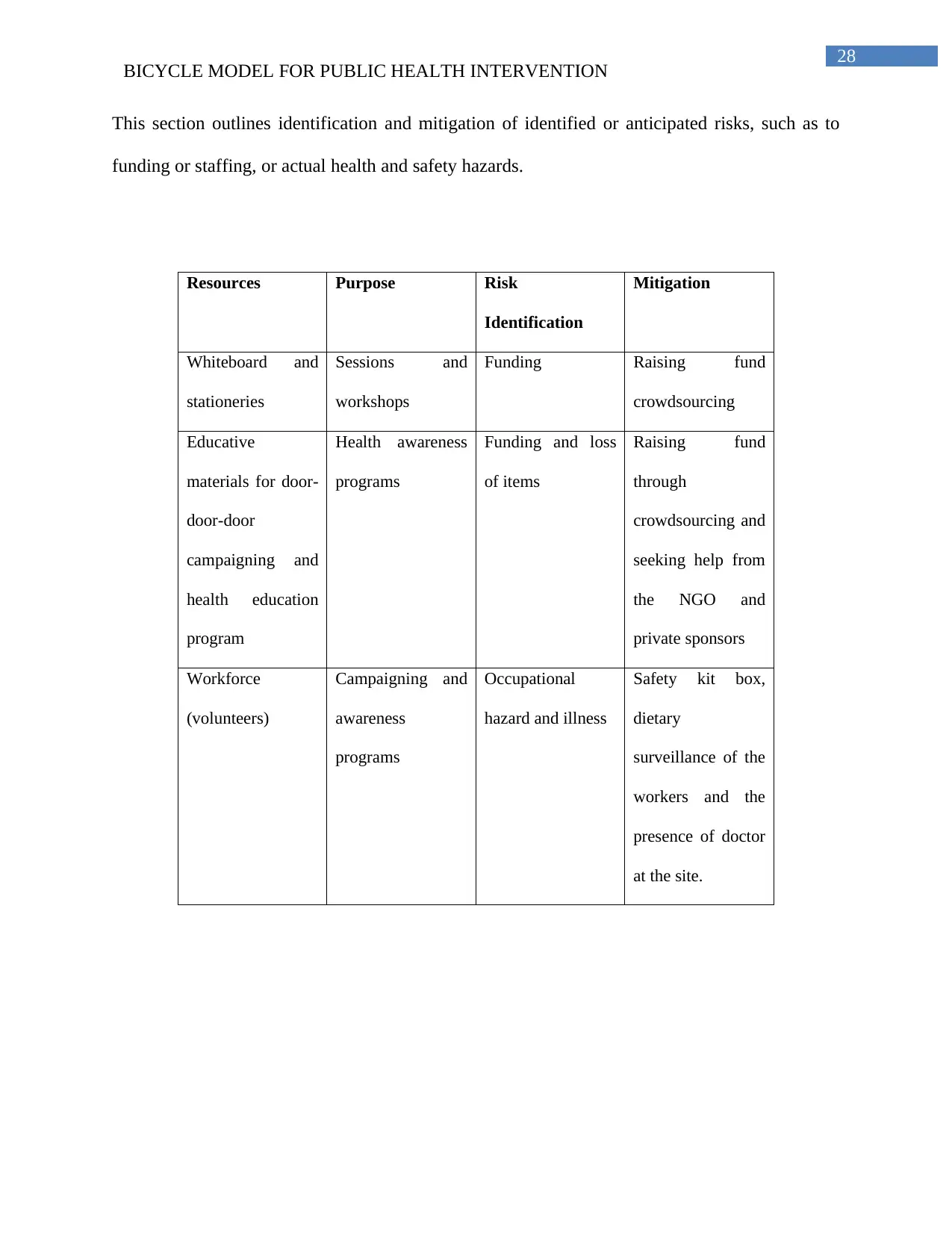
28
BICYCLE MODEL FOR PUBLIC HEALTH INTERVENTION
This section outlines identification and mitigation of identified or anticipated risks, such as to
funding or staffing, or actual health and safety hazards.
Resources Purpose Risk
Identification
Mitigation
Whiteboard and
stationeries
Sessions and
workshops
Funding Raising fund
crowdsourcing
Educative
materials for door-
door-door
campaigning and
health education
program
Health awareness
programs
Funding and loss
of items
Raising fund
through
crowdsourcing and
seeking help from
the NGO and
private sponsors
Workforce
(volunteers)
Campaigning and
awareness
programs
Occupational
hazard and illness
Safety kit box,
dietary
surveillance of the
workers and the
presence of doctor
at the site.
BICYCLE MODEL FOR PUBLIC HEALTH INTERVENTION
This section outlines identification and mitigation of identified or anticipated risks, such as to
funding or staffing, or actual health and safety hazards.
Resources Purpose Risk
Identification
Mitigation
Whiteboard and
stationeries
Sessions and
workshops
Funding Raising fund
crowdsourcing
Educative
materials for door-
door-door
campaigning and
health education
program
Health awareness
programs
Funding and loss
of items
Raising fund
through
crowdsourcing and
seeking help from
the NGO and
private sponsors
Workforce
(volunteers)
Campaigning and
awareness
programs
Occupational
hazard and illness
Safety kit box,
dietary
surveillance of the
workers and the
presence of doctor
at the site.
1 out of 29
Related Documents
Your All-in-One AI-Powered Toolkit for Academic Success.
+13062052269
info@desklib.com
Available 24*7 on WhatsApp / Email
![[object Object]](/_next/static/media/star-bottom.7253800d.svg)
Unlock your academic potential
© 2024 | Zucol Services PVT LTD | All rights reserved.





